Positions in flux: On the changing role of the artist and institution in the networked society (intro)
Posted in: Uncategorized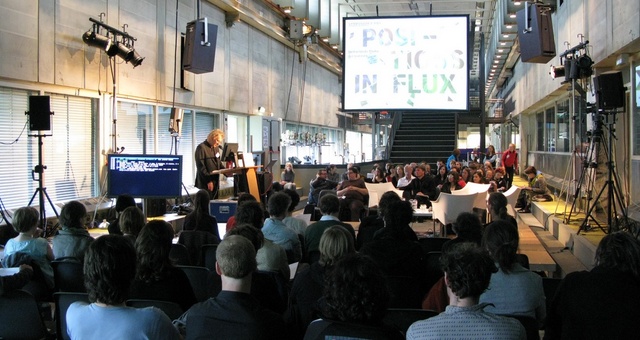

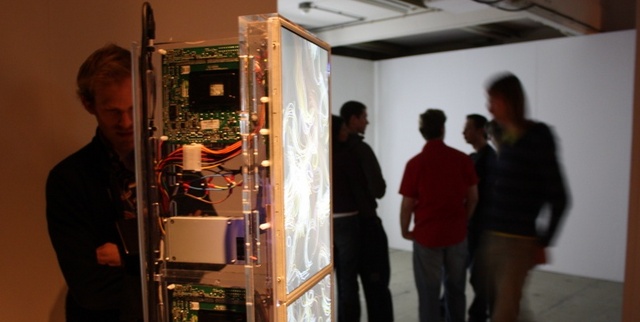
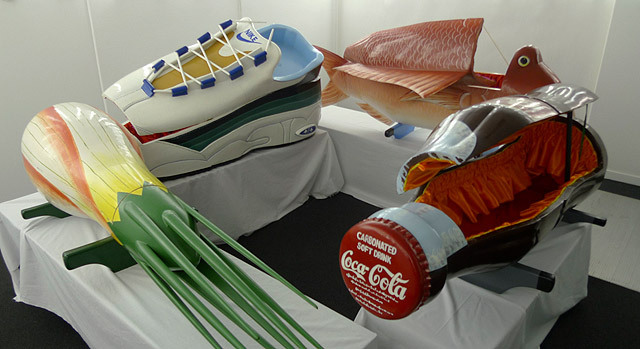
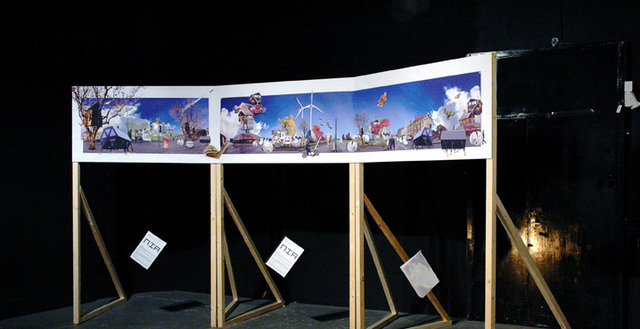
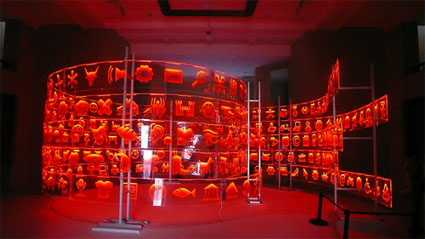
Vortex, by Christoph Hildebrand
More notes about Synthetic Times – Media Art China, an ambitious exhibition about media art running for a few more days at the National Art Museum of China in Beijing. I can’t help but mention an interesting conversation which has just started on the spectre mailing list about whether exhibiting (and blogging about?) media art works in countries ruled by a “problematic” regime is suitable or not.
One of the last two themes, Here, There and Everywhere almost consoled me for all the misery i had to face (no access to either of my own blogs) while in Beijing courtesy of the Great Firewall of China. The works selected in this chapter envision the corollaries of the networked society: the realm where the public and the private sphere merge, the issues of control and anti-control, and the challenges of the Big Brother world.
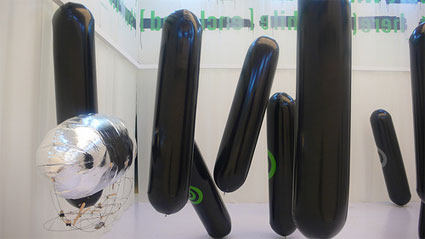
naked bandit / here, not here / white sovereign, by Knowbotic Research, is a critique of the new power structure that global information technologies are bringing about in our world. They are producing new territorial principles of order and new logics of space, as well as constituting forms of transnational power and sovereignty.
An autonomous helium-filled blimp controls and attacks black balloons, the naked bandits, which are kept captive, floating in space. The silver zeppelin, fitted with an orientation camera, is scanning the room, looking for whichever balloon is furthest away.
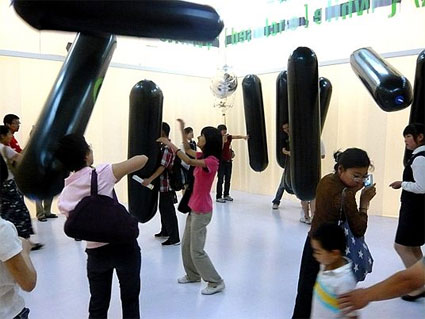
Image knowbotic research
The harmless and tech-less black balloons are the targets of the sovereign robotic logics which role is to scan, filter, profile, detect and target. Visitors can symbolically intervene in the process. by constructing obstacles in space via their physical presence (serving as additional targets) and making the sovereign space more and more un-navigable.
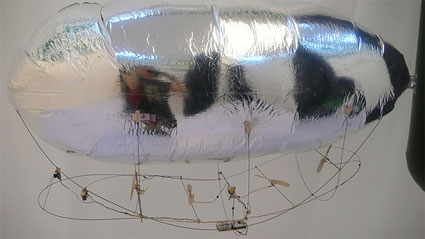
Meanwhile, coming from above, a mechanical voice repeatedly utters the words “naked bandit / here, not here” in a tone of command that is followed by a another voice representing the “naked bandit”. The sound of the installation specifies the vague status of the prisoner stripped of all rights, who is languishing incarcerated – “here” – in a very real sense. But whose legal existence is suspended – “not here”.
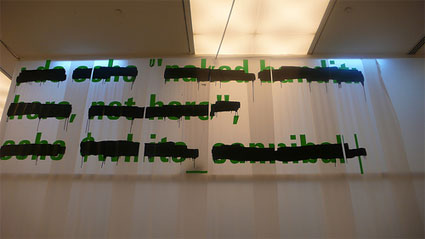
The last chapter The Recombinant Reality presents artworks which embrace the way reality is processed and meditated, revealing new types of reality that reshape our notion of existence while posing questions of epistemological urgency that characterize contemporary experience, in which a Cartesian world view no longer ensures comfort, and syllogistic reasoning finds no suitable dwelling.
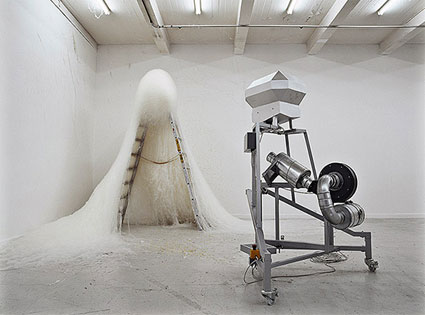
Most of Henrik Menné‘s dynamic sculptures are machines or installations are almost organic in the way they transform a material – plastic, wax, metal or stone – into objects.
56L, first created in 2004, consists of solid glue, a fan, iron, a heating element, and an engine.
56L produces a white web of glue. The machine heats up solid glue, which then flows down in thin threads in front of a fan that blows the strings in different directions and forms a surprisingly beautiful sculpture. Although the 56L machine remains the same no matter the gallery where it is displayed, the process of leading to the final glue sculpture is not only subject to change in the environment but is also relying on forces such as gravity and the peculiar qualities of the material chosen. Therefore, the exact dimensions and shape of the final work are almost impossible to control.
The work was probably the most low-tech (what is the correct expression? is it the lowest tech?) one in the show. It reminded me of Michel Blazy’s installations. The artist sets the parameters and the rest has to be left in the hands of a combination of elements.
On view until July 3, 2008 at the NAMOC in Beijing.
Beijing is the hot city for media art this month. Tonight the Summer Digital Entertainment Jam was inaugurated in a gallery at 798 (the exhibition takes place at Beijing Institute of Fashion Technology), there is the amazing Greenpix media facade and a show which has been dubbed “the biggest exhibition of new media art in the world.” This kind of heavy superlative rubs me the wrong way. The show nevertheless turned out to be an excellent panorama of contemporary media art practice (well, minus my very favourite: activism, China is not exactly big on critics) featuring works easy to understand and engage with even if you’re not a regular of ars electronica festivals. With Synthetic Times – Media Art China 2008, Beijing managed to do what some previous Olympic cities have failed to do (i’m looking at you Torino 2006): taking the Olympics as an opportunity to propose a brave, meaningful, edgy and inspiring art event. I went to the museum twice and was amazed to see so many visitors, from very age range, in the rooms. They were clearly having a good time, asking their husbands or friends to take picture of themselves in front of installations as if these were the Effel Tower and laughing all the way while playing with the works.
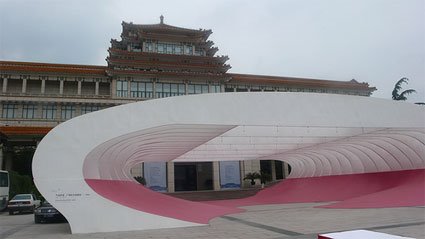
Pneumatic Sound Field, by NOX/Lars Spuybroek and Edwin van der Heide, at the entrance of the museum
Synthetic Times – Media Art China 2008 distributes the work of both established and emerging artists around four main themes: Beyond Body, Emotive Digital, Recombinant Reality and Here, There and Everywhere. I had seen many of the projects before but that didn’t prevent me from being delighted to re-discover them in a new context. However, this post will mostly focus on the works i had never
As its title suggest the Beyond Body section explores how artists are adopting electrical, poetical, olfactory or digital paths to extend the physical body. raising questions of subjectivity and the norms of ethical codes.
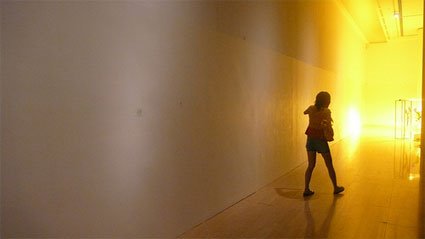
Back in 2000, Sissel Tolaas embarked on a projects related to fear. She tracked down 20 men from 20 corners of the word, with different background share one characteristic: they are afraid of other bodies for various reasons. These men were asked to carry a tiny electronic device everywhere with them. Whenever they found themselves in a situation where they were likely to be afraid, the men had to place the device under their armpits. The equipment registered the molecules of the respective sweat. This information was then used to simulate the respective sweat in research laboratories, then microcapsulated.
The microcapsulated sweat smells were then integrated into white sheets of papers placed on the surface of a white wall, without any clear borders. The smell could be released only by a gentle scratch ‘n’ sniff.
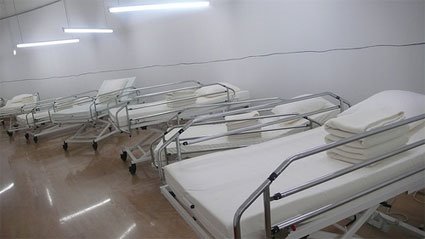
The other installation i enjoyed was Jean Michel Bruyère‘s The Path of Damastes. 21 white hospital beds, overhung by 21 fluorescent “daylight” tubes, slowly move and perform a ballet.
Each bed is equipped with an electric scissor jack, which permits a vertical movement of the bed from 38 to 81 centimetres up from the ground. It also disposes of motorized control of positioning of the upper body, which permits a roundabout movement of part of the mattress in the angle values from 0 to 70 degrees. These movements can be executed either simultaneously or independently. The 21 beds are linked together via a MIDI system to a PC which commands and synchronizes its programmed movements*. The beds are also animated individually and together they make a vast choreographical ballet. The numerous variations of creaks produced by the lattice structure under the beds in the effort to lift them compose the very music of the piece and its ballet. The beds are neatly aligned in a circular corridor. Once you enter the corridor and walk, beds keep appearing step after step, it almost seems like it will never end again.
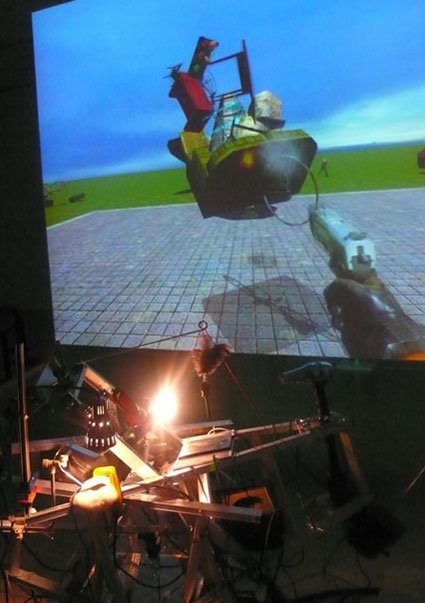
The Emotive Digital chapter engages with ideas of the emotions and the often surprising personality that digital life, machines and interactive devices might be imbued with.
Exonemo (whom Vicente interviewed a while ago) had installed a very successful artwork. Object B VS is a modified first-person shooting game. You are very welcome to play with it and control the action. However, you’ll have to count with a kinetic machine situated on the other side of the screen and assembled from a bunch of household objects, power tools and computer input devices. As wild and chaotic that the machine might seem it does click on the mouse, activate the keyboard and use a pen tablet. Its action hysterically controls an avatar in the game. Try as much as you can, managing to take control over the crazy ugly machine is just a Sysiphean task. The objects’ whimsical actions trigger automatic commands, according to which the game develops.
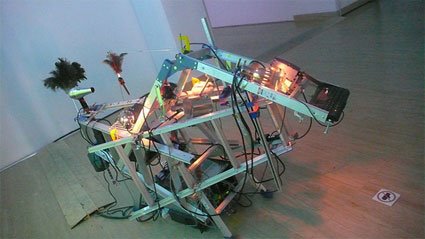
With Hand Gesture, Wu Juehei explores the way tools shape the way people work and function. Because we spend a lot of time typing on a computer, we got used to a series of “short-cuts” and they came to control our habits of using computers. It is often advised to periodically press (Ctrl + S) in order to save the materials we are working on. Thus, many people would unconsciously press Ctrl + S more than needed without even thinking, as if such action calms their conscious. A simple keyboard had its users forming various and numerous habitual hand gestures.

A keyboard is only a small piece to the puzzle, which kind of new behaviours have came to form part of our unconscious gesture through regular use of the handle of a joy pad, the opening of a cell phone, steering wheel, etc?
My photo set.
The exhibition runs at the National Art Museum of China until July 3.
Back in November i was at Medialab Prado in Madrid to visit the Visualizar workshop and i had the pleasure to hear the talk that Juan Freire gave there. I was really looking forward to know better about the thoughts of someone whose keen observation on open knowledge, digital culture and everyware’d city i was following with interest for some time. Juan Freire is one of the very very few people who keep track of what is written in the field of ubiquitous computing, free software and technology but who would also hang around with media art curators and mingle with the hackers and the urbanists. And his everyday job doesn’t have much to do with all of the above. He has a PhD in Biology, he is Associate Professor and Coordinator research group at University of Corunna. As a leader of the research group in Marine Resources and Fisheries, he was involved in several R+D projects. He collaborates with businesses, public organizations and NGOs in topics related to sustainability and environmental management. He is CEO of Fismare, an environmental consulting firm. There’s more but i’m starting to be convinced that there are hyper-active clones of Freire all over Spain.
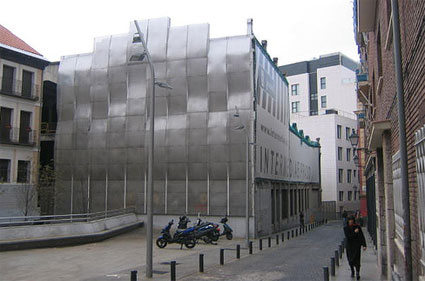
Exterior of Medialab Prado
His blogs are in spanish: there’s Piel digital (Digital skin), nomada and Ciudades enredadas (Networked cities). And obviously his talk was in spanish as well but i found it so inspiring that i’ve dutifully spent a few hours translating it. I hope you will enjoy reading it as much as we all enjoyed listening to it in Madrid.
That November evening in Madrid, Juan Freire shared with us his thoughts about public space, whether it is obsolescent or necessary, what is the meaning of the expression in the 21st century, and what could happen should public space as we know it disappear.
The video of his presentation is online and in spanish, and so are the slides of Juan’s talk. But the excerpt of his talk is here (and in english).
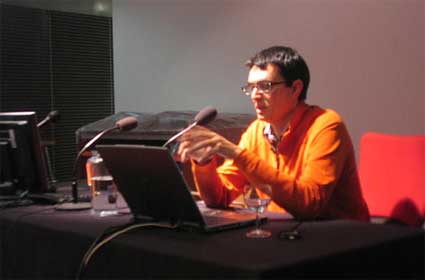
The issues he made us reflect upon that evening were:
Freire started with a tour of what the term Commons means today. The term sounds rather old-fashioned and probably most people wouldn’t feel comfortable defining it today. It’s something that comes right from Medieval Times but do the Commons still play a role in our life today? Is it limited to natural resources? Couldn’t internet be also part of the Commons? And digital knowledge? Public Spaces? What happens when we put side by side a series of elements which seem to be distinct but are getting increasingly connected such as internet, knowledge and public spaces? Juan Freire’s talk tried to explore some of those issues and bring a few answers.
What will the future bring? There are two scenarios, two alternatives of a possible future. Each of these scenarios will be more or less viable depending on many circumstances, one of them being the way we regard our role as citizens:
– we behave passively and accept the future as it comes.
– we decide that we can take an active role and grab the opportunity to participate to the shaping of our future.
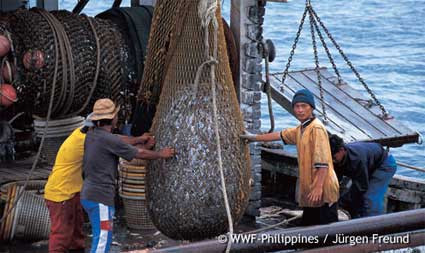
Photo WWF
Besides the Commons, exists another key concept: the Tragedy of the commons. The concept was born in the context of natural resources. Years ago, you could fish many big species in the sea. Today, we have to face an over-exploitation of the resources of sea. Many people have explained that the problem lays in the fact that these resources are for everyone to use. That’s the Tragedy of the Commons. The expression was coined by a biologist whose work had a big impact on sociologists and economists (while biologists have just started now to discover his thoughts).
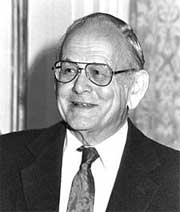 Some 40 years ago, Professor Garrett Hardin described the Tragedy of the commons using the hypothetical example of sheep in Scotland in the 19th century. Local herders share a pasture. The wool and meat from their sheep is selling well, they wish to increase their herd size and maximize their yield. More animals means more profit but each additional animal further degrades the pasture which is bad for all herders using the same pasture. However, the rational choice of an individual is selfish and stimulated by short-term gains, they won’t let themselves be worried by what is best for the whole herder community and their behaviour will eventually lead to the destruction of the resources on which they all depend.
Some 40 years ago, Professor Garrett Hardin described the Tragedy of the commons using the hypothetical example of sheep in Scotland in the 19th century. Local herders share a pasture. The wool and meat from their sheep is selling well, they wish to increase their herd size and maximize their yield. More animals means more profit but each additional animal further degrades the pasture which is bad for all herders using the same pasture. However, the rational choice of an individual is selfish and stimulated by short-term gains, they won’t let themselves be worried by what is best for the whole herder community and their behaviour will eventually lead to the destruction of the resources on which they all depend.
The solution Hardin proposes to the drama of open access is to impose an external governing structure to manage the fields. What started with a few sheep in Scotland had a big impact on our vision of the world and on the way to manage the commons.
The story doesn’t stop there, the government having shown his lack of competence to manage the commons, the ideal solution would involve privatization of the Commons.
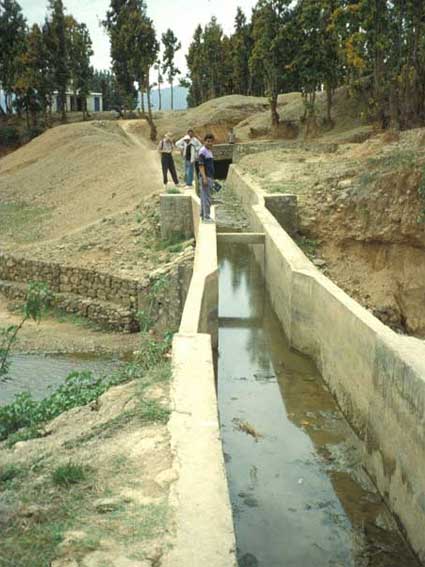
Cement-lined canal and cross-flow system in the Chiregad irrigation system in Nepal (image)
Fortunately, some people saw the glitches in Hardin’s stark statements and they started to analyze other systems. The case study of a farmer-managed irrigation system in Nepal proves the unreliability of Hardin’s view. Farmer-constructed canal which seem rather simple and primitive were actually much more efficient that the ones built for efficiency with a greater expense of money by the Nepal government. The traditional ones irrigated more crops than the newly constructed, government-owned ones. The infrastructure was old-fashioned but they were better managed. The problem didn’t lay in the engineering but in the way the canals were managed. The new infrastructure that came with government ownership had the effect of destroying the traditional rules established over generations to manage common resources.
The Nepal example and many other have shown that the Commons can also be managed efficiently using methods which do not have to involve privatization or government-ownership of the resources.
An excess of regulations actually leads to another tragedy, the Tragedy of the Anticommons. The term was coined in 1998 by Michael Heller, a professor at Columbia Law School. In his papers Can Patents Deter Innovation? The Anticommons in Biomedical Research and Do Formal Intellectual Property Rights Hinder the Free Flow of Scientific Knowledge? An Empirical Test of the Anti-Commons Hypothesis, Heller argued that patents are an obstacle to innovation and sharing of knowledge in science. Biomedical research is one of the key areas where competing patent rights could prevent useful and affordable products from reaching the marketplace.
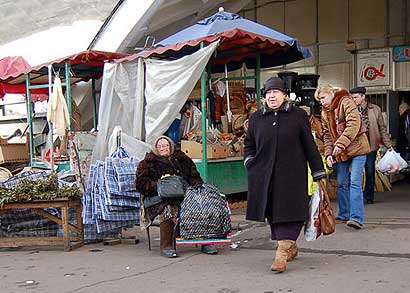
Image BBC news
Heller also observed public spaces as his paper The Tragedy of the Anticommons: Property in the Transition from Marx to Markets demonstrates. His essay wonders why many storefronts in Moscow are empty, while street kiosks are full of goods? Heller observed that in post-Communism Moscow there were a lot of open air kiosks, but also a lot of empty stores. He concluded that in the transition from Marxism to capitalism, those commercial spaces had been over-regulated making it difficult for a startup retailer to successfully negotiate for the use of that space.
Lawrence Lessig mentioned and commented on Heller’s paper and even transfered the discussion about the commons from biomedicine and public space to internet and knowledge. The concepts of Commons and Anticommons are thus far from obsolete and internet has revived their relevance.
We often wonder why people attend a particular space rather than another one and how they use that space. Public spaces are often designed from top down with little attention on how citizens will eventually use them which will obviously lead to yet another example of the tragedy of the anticommons.
The first image Juan Freire used to illustrate his point was made by Nicolas Nova in Amsterdam. It shows a street that “defends itself” with elements that prevent people from using the street. This is a case of anticommons.
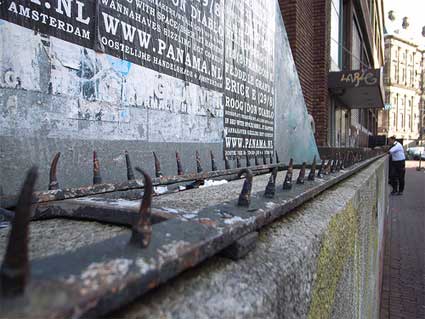
Photo Nicolas Nova who has more images and thoughts
On the picture below, congested traffic in the streets of Bangkok. This looks like an example of the Tragedy of the Commons. The excessive use of a road that everyone is free to ride makes the road useless, annihilates the public space.

Image source
The problem is that we haven’t progressed much since the 19th century, which is when an article published in the magazine of the Franklin Institute showed up. Titled On the Best Arrangement of City Streets, the publication(image) gave an example of excessive planning which forgets the role and needs of the citizen. A drawing and two pages of text describe a mathematical formula, an urban science, that ensures the “right” agency of the streets. Such magical formula can lead to an under-used public space. Unfortunately, on a certain number of aspects, we haven’t found a method that improves the 1877 drawing.
There’s another problem:
Why is that so? Despite the fact that we live in a capitalist system, there are antagonistic concepts of capitalism but there are also models of capitalism which, although they are very antagonistic, coexist in the same space: the oligarchic model, the State model, the bureaucratic model. They don’t really follow the rules of the market. There’s a whole structure that prevents the market economy to function properly or that allows it to function only for a few entities.
But there is now another form of understanding the market and it’s brought to us by internet. “Markets are conversations.” The market here is seen as a deliberate form of aggregation of information, debate, decision making, deliberation between individuals. This is of course an ideal vision of how the market should function and it takes life when a series of barriers of access disappear or when a system enables information to flow freely and be accessed by everyone.
See Good Capitalism, Bad Capitalism, and the Economics of Growth and Prosperity, by William J. Baumol, Robert E. Litan, and Carl J. Schramm.
The solution is not only to eliminate “bad” capitalism but the alternative is “good” capitalism, the one that envisions market as a conversation. That’s where internet plays a key role, it eliminates those barriers and when it functions properly, it enables this idea of perfect markets with information that goes both way. This model is hypothetical but we are getting closer to it.
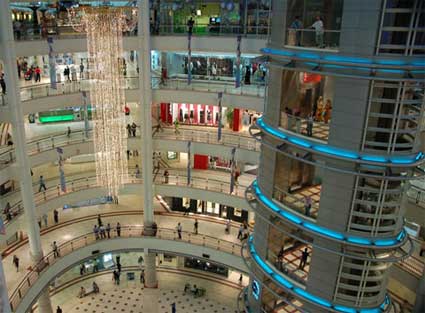
The public spaces we inherited from the 19th century can be called modernist. They were designed from top down, by an elite that cared for the wellbeing of the citizens yet, they have failed under several points of view. Those public space have given way in the 20th century to what we can call the Post-Modernist Public Spaces (even if the expression is questionable). They emerge as an answer to the obsolescence of the previous ones. If people are not going to the public spaces anymore, new -and this time private- opportunities are created for them: the shopping malls, the perfect example of post-modernist public space.
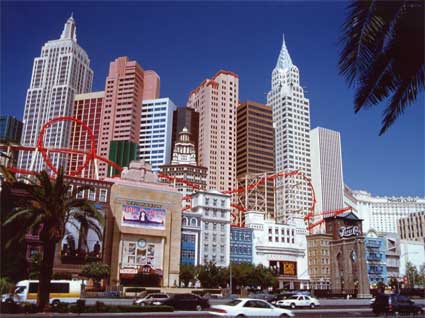
Las Vegas
Many people believe that cathedrals have been substituted by shopping malls. For many they are only simulacra of the city. The acme of this idea is Las Vegas. A project of creating a new Las Vegas in Los Monegros (Aragón, SP) could turn out to be an interesting experiment. The shopping mall is the mirror of the society of spectacle. Shopping malls are the new public spaces but not all evil comes from them: in many cases we use them because we don’t have alternative or because they represent the best alternative at our disposal. Private initiative, in some cases, has managed to provide us with what public spaces designed by the State have not offered us.
The next question is therefore: How can we take back those old public space and update them? What is left of them?
Berkley University urbanist Christopher Alexander has written: For centuries, the street provided city dwellers with usable public space right outside their houses. Now, in a number of subtle ways, the modern city has made streets which are for “going through,” not for “staying in.
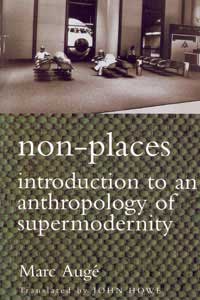 The traditional public space, made of squares and streets, have become what anthropologist Marc Augé calls the “Non-Places”. Rem Koolhaas goes further by christening them as Junkspace. In the post-modern vision, we move from private space we have to pay for and, as they are often located outside city centers, we have to drive through junkspace, non-places, spaces which have no immediate utility. The problem in the scenario is that interaction seem to have vanished. Social networks have shrunk to our own family circle or to shopping malls. A huge part of social interaction is missing. Are we ready to loose it? If we translate the scenario to the internet we have to imagine an internet where we can only find a commercial space and all the rest will just be junkspace.
The traditional public space, made of squares and streets, have become what anthropologist Marc Augé calls the “Non-Places”. Rem Koolhaas goes further by christening them as Junkspace. In the post-modern vision, we move from private space we have to pay for and, as they are often located outside city centers, we have to drive through junkspace, non-places, spaces which have no immediate utility. The problem in the scenario is that interaction seem to have vanished. Social networks have shrunk to our own family circle or to shopping malls. A huge part of social interaction is missing. Are we ready to loose it? If we translate the scenario to the internet we have to imagine an internet where we can only find a commercial space and all the rest will just be junkspace.
To put the finishing touch to the panorama we cannot leave aside the issue of publicity. The spaces between the private spaces we shop to, those junkspaces, are getting filled with advertisement. The vision about publicity is usually very critical and negative. When the Mayor of Sao Paulo in Brazil decided to eradicate any kind of advertisement in the city, his move has been welcome with not only wonder but also praise. Sao Paulo is the third city in the world. It counts almost 11 million inhabitants. Citizens, foreign observers, the press applauded the measure. Those who live from the revenues of publicity were less enthusiastic about it. But to which extent isn’t publicity part of our genome, of our ADN today? If you look at photos and videos of Sao Paulo without its billboards and advertising posters you get a slightly deshumanized vision. The structures that supported advertising are still there but they are empty, switched off. The buildings do not seem to be complete anymore. It seems that a crucial part of the city has been lost in the process. Maybe this effect is only transitory.
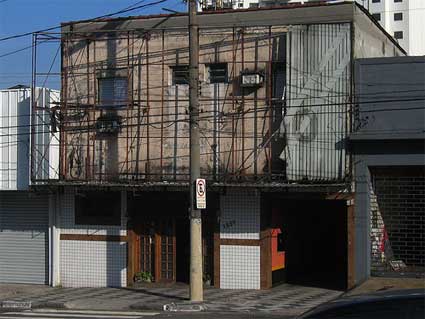
Image Tony de Marco
The following question is:
The answer is not clear of course.
Do public spaces still exist? Or are we left with only post-modernist spaces, connected between themselves by non-spaces or junkspaces?
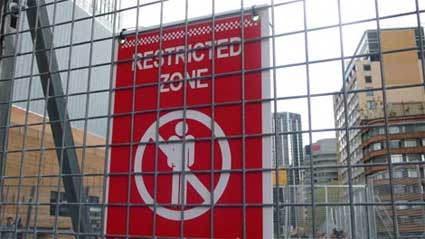
Image city of sound
Freire illustrated the point by making an exercise of inverse engineering. The case study is the APEC (Asia-Pacific Economic Cooperation) Summit which took place last year in Sydney. It shows clearly what remains of a city when access to all public spaces is prohibited. All the security measures were taken to ensure that the event, the most impressive gathering of Heads of State the city had ever witnessed, would unfold without any glitch. Two blogs such as Subtopia (Fenceland and Subverting “Military IKEA”) and City of Sound (The Anti-Fun Palace: APEC Fence, Sydney lockdown) documented and analyzed quite shrewdly what happened in a city where access to public space was negated to its inhabitants, where extreme measures of security bring a whole city to a standstill with, for example, a 5km fence surrounding the Opera House area and Google Earth/Maps images of the area (and others) being blanked out or blurred. Important zones of public use where most of the city life was usually concentrated were militarized, closed down or saw their access strictly restricted.
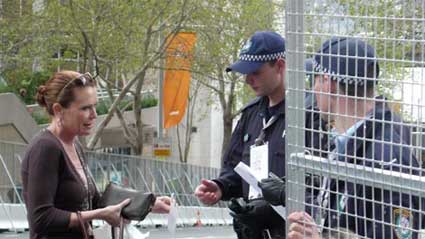
Image city of sound
Streets, bike lanes, jogging tracks were closed, spaces where people would go to meet and chat were unaccessible. Fences had taken over the city. What is interesting is what you cannot see in the pictures collected by the bloggers: a way of living in the city being destroyed. When the public space and even the junkspace are eliminated from urban life, the city changes radically. Although we tend to be very critical of the way public space is deteriorating, is becoming useless, etc. reality is that public space is still a fundamental part of the city and not only as place of transit from one shopping mall to our house. By making this forced exercise of inverse engineering, we discover the value of places and things we have stopped to pay attention to.
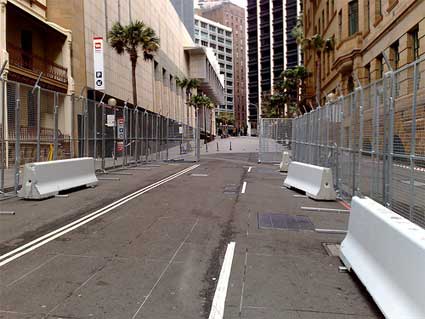
Image subtopia
What is a public space? It depends on the capacity of auto-organization but also on market and community management
Public space depends on the capacity of auto-organization that we have. We must see further the concept of public space designed by the government for the citizen. The space cannot really be public if it doesn’t come with a certain capacity of self-management. Public spaces are hybrid, they combine market with community processes. The Common is much more sophisticated than we might think.
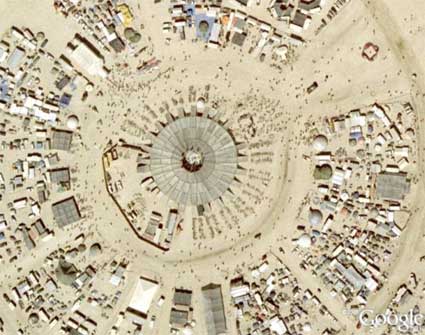
Image Google earth Burning Man
A fascinating exploration of public space is Burning Man. An outsider who attended the Fallas in Spain compared them with the Nevada-based festival. The former is organized by the State. Just after the party, the streets are filthy, there are traces of chaos all over the city. Burning Man instead is built and de-constructed by the community of participants without any top down supervision. After the party, the desert is left to its pristine state. No trash is left, the space is clean. The process is totally self-organized. The Burning Man community is able to create a public space which is not only dynamic but also ordered.
Burning Man is a public space that lives at the margins of Hardin’s theories.
Burning Man Time Lapse video
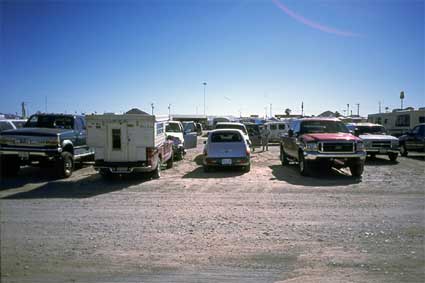
Image polar inertia
Another example is Quartzsite (Arizona) which functioning and dynamics have been described in Kazys Varnelis and Robert Sumrell’s book Blue Monday: Stories of Absurd Realities and Natural Philosophies (i’ll join Juan Freire in his enthusiasm about the book, it’s a gem.)
Quartzsite is a desert town of some 3,000 people that every Winter swells to over a million residents (making it the 15th-largest city in the USA) as a horde of modern nomads descends upon it in their motorhome. With very little planning, they create a city which works perfectly, it has its own dynamics, its own market (unlike Burning Man, there is a money-based economy), exchanges of goods and services, etc. It is spontaneous, yet very efficient.
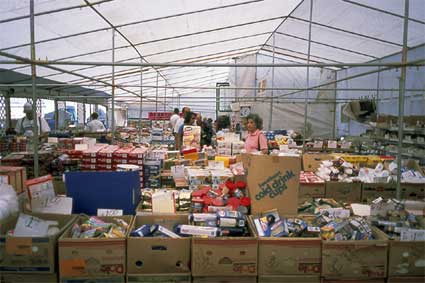
Image polar inertia
As Freire added, this is not the future of our cities but, making once again some exercises in reverse engineering, there are a few lessons that can be learnt from the Quartzsite experience. People as a group have far more intelligence than most would suspect. Sumrell and Varnelis call it ‘swarm intelligence’ – a human version of the behaviour often seen in ant colonies and the like.
Juan Freire then illustrated how hybrid a public space can be by showing us the main square of his city, A Coruña (Spain)
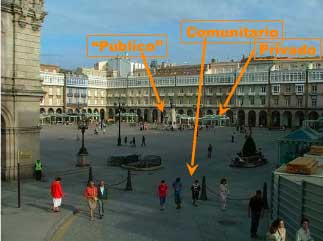
Public space functions quite well, it’s a very active area of the city. The secret to its success is the mix of private, community and public initiatives which take place on the Square. To be lively a square needs bars and there are plenty of bars here. There is also some space for people to self-organize and develop freely their own activities in a way that neither a bar nor a shopping mall can provide. The other requirement is some entity to think and design the whole experience and to create some urban furniture and other elements susceptible to foster all those activities.
Internet is the element missing from today’s equation. We cannot leave the internet aside anymore when we discuss public space. We live in a networked society. Many people say that we live both a physical life and a virtual life but Freire thinks that these two realities are getting more intertwined every day.
The networked society opens a new Commons. People don’t call it this way but the digital element is nevertheless essential. Internet was designed to be free and the knowledge that comes with it should be free as well. Although there is a huge amount of effort from above (copy right) to prevent knowledge from being free, it is nevertheless freeing itself.
We should see beyond the modernist vision of a traditional, well-planned public space. Today we are living a reality which is quite complex, hybrid and multi-faceted. Freire calls it an hyper-reality (in the “hyper-link” sense). Our public space today is hybrid in two ways:
– its environment is both physical and virtual,
– its management which is public, private and community-based at the same time.
1. free knowledge,
2. free electro-magnetic space,
3. a post-spectacular architecture,
4. a digital skin layered over tarmac and concrete.
A few words about Free Knowledge, starting with a quote from Stephen Downes: The greatest non-technical issue is the mindset. We have to view information as a flow rather than as a thing. Online learning is a flow. It’s like electricity or water. It’s there, it’s available and it flows. It’s not stuff you collect….
Many people are horrified by the fact that knowledge flows continuously. They wouldn’t have any qualms about electricity flowing around us freely but they find the idea of a never stopping flow of information highly disturbing. They would like to be able to control it, to store it on the shelves of a library. But that’s a lost battle because information is going to increase more and more every day. An you know what? That’s a good thing. Especially if we manage to become curators of information. “We”, the users, not the so-called experts. We must become “digital chefs” and cook delicious dishes of information. The ingredients are out there on the web, the kitchen is packed with instruments which are free, or very cheap even when they come from some private or commercial initiative like Yahoo! or Google.
The second element we need is what Jose Luis de Vicente calls the “free spectrum“, we need to reclaim the use of the electromagnetic space. We need these electromagnetic infrastructures, no matter how intangible they are. As JL de Vicente wrote: “The radio spectrum – the electromagnetic space through which radio and TV broadcasts, mobile phone and GPS signals and WiFi networks circulate – is the real estate of the information society.” We can’t guarantee the freedom of information if we can’t control the structure that gives us access to it.
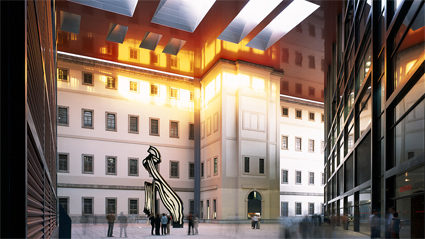
Reina Sofia Museum Extension, Madrid. Photo: Philippe Ruault (via arkhitekton)
Thirdly, we need those architects whom Freire calls the “post-spectacular architects”. Sure, we like the architects of the “spectacular”, we like Frank Gehry’s Guggenheim, Moneo’s addition to the Prado, Jean Nouvel’s extension of the Reina Sofia, etc. But these spaces have not been designed for physical nor digital interaction. We need architects who think from the perspective of the people who will “use” the spaces, not just the tourists. But how should we design with a perspective of participation? The focus should be less on the aesthetics and more on the efficiency and on the functionality (what are we building for?) These ideas won’t lead to an anti-aesthetics but to a new form of aesthetics. This aesthetics will not only be better suited to our requirements but it will also start adopting something of the open source philosophy, by sharing designs, methods, etc.
Besides, this architecture will be cheaper and faster. The main problem is that cities change very slowly. We live in the same Madrid as centuries ago, even if society is not the same as centuries ago. Physical changes are way slower than intangible changes. We’ll never manage to keep pace with society’s changes but we can do something about it.
Freire gave a few examples of the kind of projects that he would like to see bloom over the cities, adding that some of them start to get out of the “workshops ghetto” and appear in glossy magazines:
– Ecoboulevard of Vallecas near Madrid, designed by [ecosistema urbano]. Fast architecture that solves several problems while proposing an innovative and appealing aesthetics.
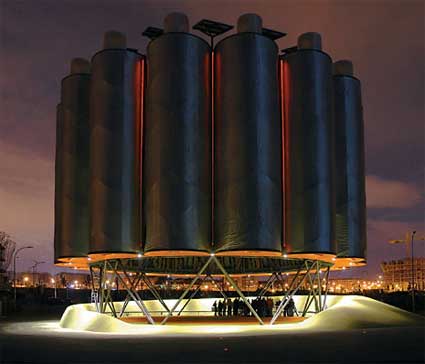
Ecoboulevard
– Santiago Cirugeda‘s Recetas Urbanas (Urban Prescriptions). Cirugeda hacks the legal code. Because his home town would not authorize him to build a playground, Santiago Cirugeda obtained a dumpster permit and installed a playground that looked like a dumpster. He also built and occupied a rooftop crane that passersby believed was there only to move building materials. There used to be a video on you tube where the architect used Playmobil toys to demonstrate how to build a temporary flat in your rooftop. The solutions Cirugeda proposes are cheap, fast, accessible to everyone and the key ingredient is to find out the gaps in administrative structure and official procedures, to intervene where the law falls short.
Is Cirugeda doing art, architecture or activism? Probably the three of them but does it really matter?
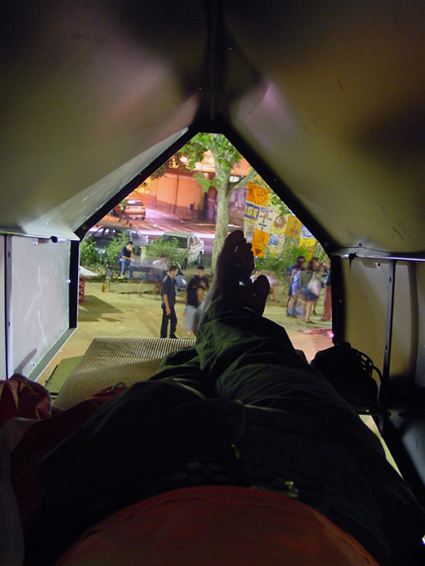
Inside Cirugeda’s insect house
– Vicente Guallart whose work is more often found in museums than in the streets, probably because his vision is still too futuristic. His Sociopolis project is a neighbourhood designed with a mind set on efficiency, functionality, digital networks,
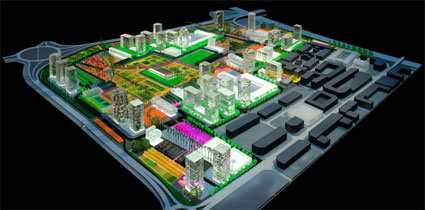
Sociopolis
– Jose Perez de Lama, a member of the Sevilla-based collective hackitectura, believes that we need to build layers of digital information over physical spaces. Architecture, in its traditional definition, is relevant but not central. The space is built using mostly intangible elements: electronic flux, interfaces, audio, projections, words, bodies, landscapes, etc. We need to combine the tectonic with the electronic.
Hackitectura has illustrated their concepts with a series of interventions in public space. The most famous of which being the wikiplaza project in Sevilla which regards public space as multi-layered: there are bars, grass, cements and tarmac but there’s also the digital space.
Finally a bit of futuristic speculation. Future is in the hyperlocal networks. Paradoxically, internet has allowed us to be globally connected but it doesn’t help us enough when we want to be connected with what is in our own neighbourhood. That’s mobile telephony that we use (intensely) for local connections. The development of hyperlocal networks is a big opportunity, a double opportunity: both from the commercial and the citizen point of view.
Last July, Bruce Sterling wrote an inspiring article, Dispatches From the Hyperlocal Future. A protagonist narrates his life in 2017 and how he moves in those hyperlocal networks.
In the 20th century appeared the Situationists. Among their ideas was the Dérive, an invitation to use the city in a new way. The Situationists failed in their attempt to radically change the world but they manage to predict what the future would bring. We use more and more the city like they said we ought to. This concept of the city as a space for exploration is getting more and more appealing.
The hyperlocal networks are made of elements which are already existing around us but they still have to be connected one to another. However, every day new initiatives appear that tell us that the situation is about to change. Here’s a rapid list of projects which Freire find as thought-provoking as inspiring. They might seem to be disconnected but if you put them together in a broader picture, you’ll see glimpses of a new reality emerge.
– hyperlinks with physical space, like google maps.
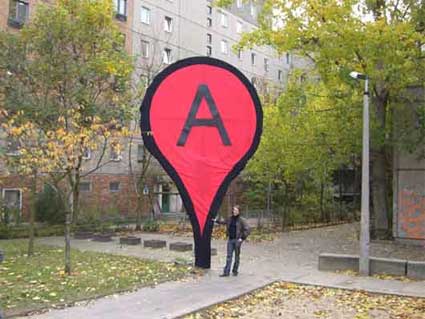
Aram Bartholl‘s project The Map
– the concept of ubiquitous computing which highlight the upcoming urbanism 2.0, cf. Adam Greenfield‘s essay Everyware.
– mobile internet, ubiquitous connectivity (ex. urban tapestries).
– the internet of things, of objects, what Bruce Sterling defined Spimes back in 2004. More in his book Shaping Things.
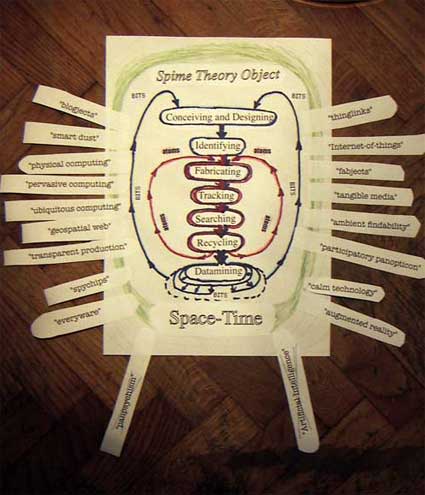
Image Bruce Sterling
– new initiatives like Semapedia to hyperlink the whole world.
– new possibilities to visualize people and the flux of information in urban space. One of the most famous example is Real Time Rome, the MIT SENSEable City Lab‘s contribution to the 2006 Venice Architecture Biennale.
– collaborative cartography. Geographical information is still private and is often submitted to copyrights. People can view the database but they are not allowed to take the data and use them as they wish. Fortunately some initiative are attempting to put an end to the geo-monopoly. E.g. the open and collaborative OpenStreetMap.
– the mash-ups which use google tools to propose more personal visions of space. Besides, these mashups enable users to monitor what is happening in physical space right here and right now (to track fires in California for example).
All these initiatives demonstrates that we have the opportunity to layer a digital skin over the city. The skin is not just a fad, it will make the urban experience more meaningful and useful. E.g. Urban Tapestries, a research project born in 2003, Dodgeball, Outside.in which aggregates, tags and structures local information available online, using thus individual activities to build instruments useful for everyone.
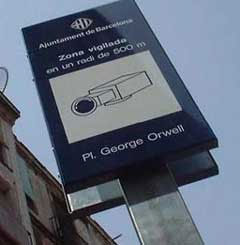 G. Orwell place, Barcelona
G. Orwell place, Barcelona
Freire, being the astute and realistic observer he is, also pointed out the darker face of public spaces by quoting Stephen Graham who wrote in Subtopia:
The real architectures of control already are algorithms, software, databases and microelectronic tracking systems, satellites and sensors, linked intimately to physical spaces, infrastructures and bodies, rather than the obvious architectonic brute force of walls and ramparts.
The future might be of the Orwellian type or it can be the one that Freire described in his presentation. It’s in the hands of citizens and whether they will adopt an active or passive role. Today we have the opportunity not only to protest but also to take things in our hands and push changes.
However, there’s another danger: the one created by people who do not understand internet. German philosopher and sociologist Juergen Habermas wrote that … in the context of liberal regimes, the rise of millions of fragmented chat room across the world tend instead to lead to the fragmentation of large but politically focused mass audiences into a huge number of isolated issue publics.
Freire believes that instead of just creating fragmentation, internet enable us to go beyond fragmentations.
Facebook, for example, counts many advantages but also many downsides. It’s a network you can close and keep for your friends exclusively
LifeAt creates private online communities for residential properties. It’s closed and “secure” with control over who has the right to use it and what can be published or not. There’s an absolute control over people and content. The model can be interesting for commercial companies or for facebook but in the context of public space, it would do more harm than good, it would mean applying post-modern concepts to new hybrid space.
As a conclusion, Freire quoted an article that urbanist José MarÃa Ezquiaga wrote for national newspaper El Pais. He adopted the Mai 68 moto “Sous les pavés la plage” (Under the cobblestones lies the beach) to tell us that we have to see beyond the ugliness of cobblestones and uncover the beaches that exist beneath them. Freire added, this time quoting Jose Pérez de Lama, that above the tarmac there is a digital layer. Although that layer is neither tangible nor visible, it set to fulfill a crucial role. If we use this additional layer intelligently and openly, then the future might indeed be appealing.
The Q&A which followed was almost as fascinating as the presentation itself but i’m done with the translation.
Some choose to embrace art from China, others believe that we should boycott their art as much as the political context. If you follow this blog you’ll know on which side i stand, i can’t get enough of the China art scene. All my China art-mania didn’t save me from being castigated: my blog has been banned in China (euh? what happened here? too much pornography?)
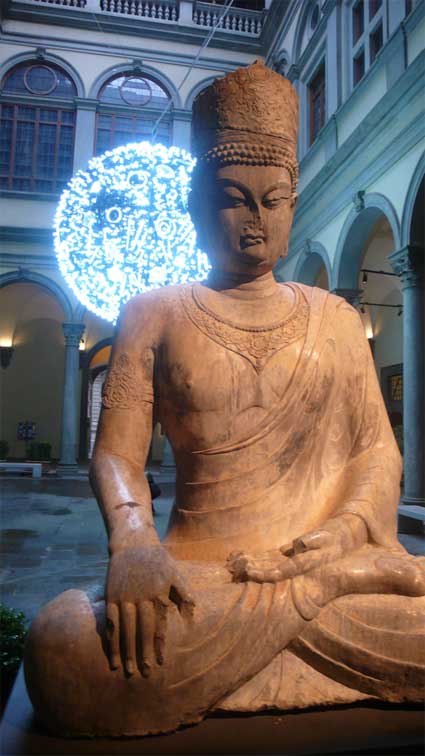
Courtyard of Palazzo Strozzi, Florence
Unrepentant and un-vindicated, i paid a second visit to Florence this year, to check out China China China !!! at the recently opened Centro di Cultura Contemporanea Strozzina (CCCS). The title of the exhibition reflects quite well the plethora of contemporary Chinese art exhibitions which have been sweeping Europe over the past few years.
I recently complained that i keep seeing works by the same elite of artists again and again at every exhibition about Chinese art i happen to visit. Maybe that’s one of the many reasons that explain why i like it so much. It’s a kind of McDonald’s effect, i know before i enter what i’m going to find inside: laughing men, a spat of blood here and there and oh! look! Mao has grown tits!
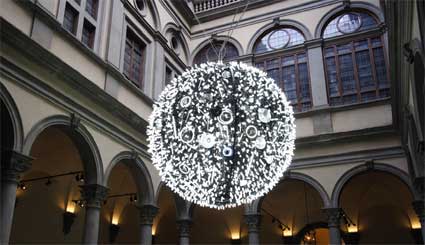
Artificial Moon, Wang Yu Yang, first seen in Beijng last Summer
However, the Florence exhibition is different on several levels. The first reason jumps at you as you enter one of the first rooms of the exhibitions and discover a series of videos and texts. Each of them document how several exhibitions have recently felt the wrath of the very elastic rules that guide censorship in China. They had to close because some works contained nudity or were judged too “unstable”.
Not only does China China China!!! offer a clear vision of the difficult situation that curators, gallerists and artists alike have to deal with, it also takes up the challenge to give visitors a glimpse of the way Chinese artists echo the complex reality of a country facing an historical change and cultural transformation. To ensure a balanced and somewhat independent view on the “China phenomenon”, the CCCS invited three “insiders”, all of whom live and work in China, are not associated with government institutions, and have worked independently for years. Each of them has a very different but complementary and always critical perception of China’s art scene and its mechanism. The result is nothing like the Chinese art you’ve been seeing around Europe and the USA over the past few years.
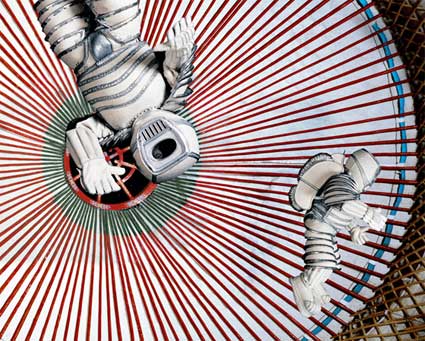
Wu Ershan, Nomadic Plan in Outer Space
Beijing-based artist, curator and founder of the independent Art Lab Li Zhenhua curated the section that i found the closest to my own interests. His approach focuses on common cultural roots between different populations, both between China and its neighbours and, at the more macroscopic level, between East and West.
His contribution in the exhibition revolved around the figure of Genghis Khan, founder of the Mongol Empire, the largest contiguous empire in history. He came to power by uniting many of the nomadic tribes of northeast Asia. After founding the Mongol Empire, he set himself the goal to invade and conquer East and Central Asia. During his life (c. 1162-1227), the Mongol Empire eventually occupied most of Asia.
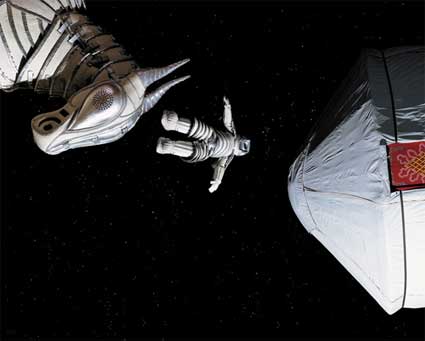
Wu Ershan, Nomadic Plan in Outer Space
Li Zhenhua chose to invoke his figure as a symbol of the pioneering spirit and communication between civilizations. However, the focus goes beyond the historical past and leads to an analysis of the roots of possible visions of the future of humanity. His section, entitled “Multi-Archaeology”, explores cultural identity, the way individuals are shaped by constant change and reciprocal cultural influences, and thereby the relative value of concepts such as “nation” or “race”.
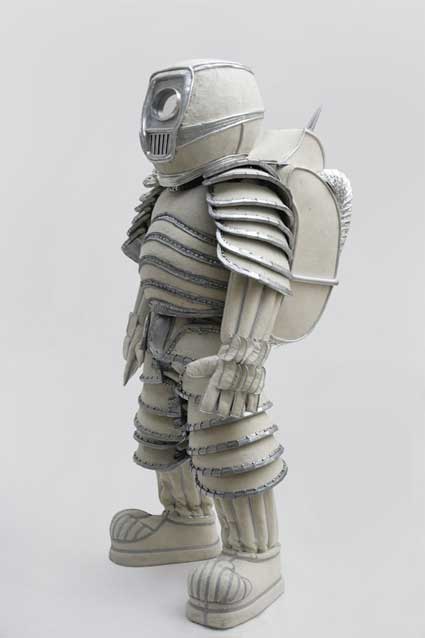
Wu Ershan, Nomadic Clothes / Space Suit
His selection includes Nomadic Plan in Outer Space is a body of work by Mongolian artist Wu Ershan that comprise, sculptures, installations and photographs along with the costume and photos from the film which represent Mongolians’ nomadic life in the universe. They allude to a non-linear story where the past, the present and the future merge.
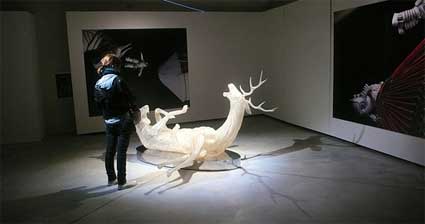
Wu Ershan, The first infant who cried aloud is Tiemuzhen, 2008
The art video by Zhao Liang and Shen Shaomin documents the situation on the Chinese border with North Korea and Russia. An analysis of the consequences of the Mongolian invasion by Genghis Khan on Asiatic culture is compared to the impact of modern globalization, in the constant cultural interchange between East and West. In the same time, the works highlight that the Chinese are not the homogeneous, mono-faceted people we often refer to.
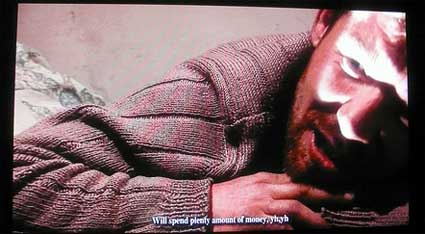
Shen Shaomin’s subject is particularly melancholic and poignant. His video, called I am Chinese, takes place in Hongjiang, a village on the border with Russia. During the First World War, when Germany invaded Russia, some Russians on the Chinese border were forced across the Heilongjiang River to Hongjiang Village. Other immigrants joined during WW2 and the October Revolution but the whole Russian community was still struggling to integrate with Chinese society. Things turned really sour during the Chinese Cultural Revolution (1966-1976) as some of the Russians in the village were suspected of being spies and the village got nicknamed “the village of spies”. In order to be finally accepted by the Chinese, the elders in the Russian community suggested that marriage should be allowed only to pure Chinese in order to mask the Russian origin of their offspring. This of course resulted in genetic modifications and the birth of a mixed culture.
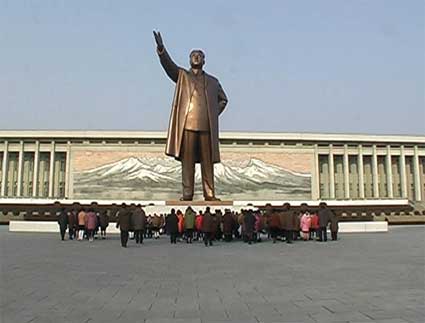
Screenshot from Return to the Border by Zhao Liang, 2005
Equally moving is Return To The Border, a documentary in which Zhao Liang narrates the return to his hometown, Dandong, near the border with North Korea. Until the 1990s, these two socialist states were allies. However, the minute China concluded a trade treaty with South Korea, trade and cooperation was terminated and the people were forcibly plunged into opposite camps. Traveling along the river that separates the two countries, the filmmaker examines what is left of the socialist dreams on both sides of the water.
Video extract:
In his section, Davide Quadrio, director of BizArt Art Centre in Shanghai, developed a very engrossing multi-screen installation entitled 40 + 4 Art is not enough, not enough! Working together with documentary filmmaker Lothar Spree and filmmaker Zhu Xiawen, he interviewed forty different artists in Shanghai and asked them a series of questions about the role of the artist, their relationship with the external world, the social consequences of their work and the international market effects on traditional artistic production modes. The video, edited from 90 hours of film, offers a portrait as much as a dynamic investigation into the fast changing landscape of Shanghai’s art scene. On another level, the film stretches beyond the limits of Shanghai and offers a study of the contemporary art scene in China that reveals what lays beneath the glossy, enchanting and almost uniform surface Westerners are used to see in exhibitions.
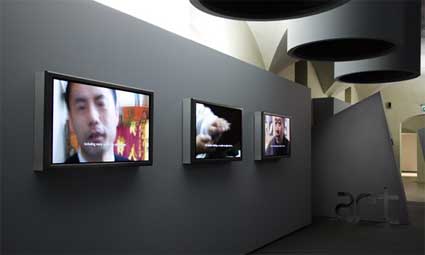
The third curator, Zhang Wei, is the director of Vitamin Creative Space Contemporary Art in Ghuangzhou. With Throwing Dice, she composed a mosaique of individual visions of human existence in a constantly changing world. The videos of Kan Xuan, Pak Sheung Chuen and Yang Fudong, Cao Fei’s explorations into Second Life, technological installations by Chu Yun, and paintings by Duan Jianyu offer individual stories that engage the spectator in the discovery of the artistic sensibility in China today.

Tseng Yu-Chin, Who is listening (screenshot)
China China China!!!, Chinese contemporary art beyond the global market is on view at the Centre for Contemporary Culture Strozzina (CCCS), part of the Fondazione Palazzo Strozzi in Florence, until May 4, 2008.
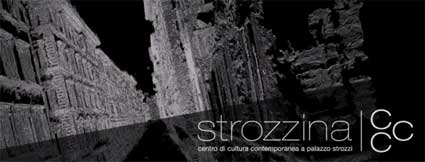
Another date to add in your agenda:
On May 15, Exploded Views – Remapping Florence, a specially-commissioned new installation by Dutch media artist Marnix van Nijs, will premiere at the CCCS.
Just back from Frankfurt where i participated to the marvelously organized and well-attended Node08 Forum for Digital Art conference. As i was in town for two days, i visited All-Inclusive. A Tourist World at the Schirn Kunsthalle.
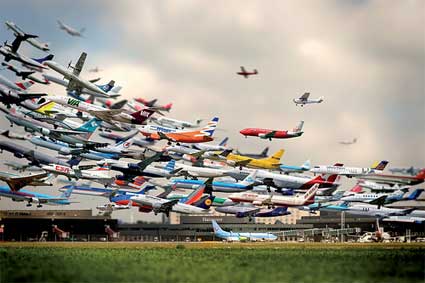
Ho-Yeol Ryu, Airport, 2005. Courtesy Ho-Yeol Ryu
All-Inclusive. A Tourist World presents works from 30 artists depicting and commenting on various phenomena influenced by the continually growing tourist industry.
Vladimir Raitz pioneered modern package tourism when in 1950 his company, Horizon, provided arrangements for a two-week holiday in Corsica. For an all inclusive price of £32.10s.-, holiday makers could sleep under canvas, sample local wines and eat a meal containing meat twice a day. Within ten years, his company had started mass tourism to Palma, Lourdes, Costa Brava, Sardinia, Minorca, Porto, Costa Blanca and Costa del Sol.
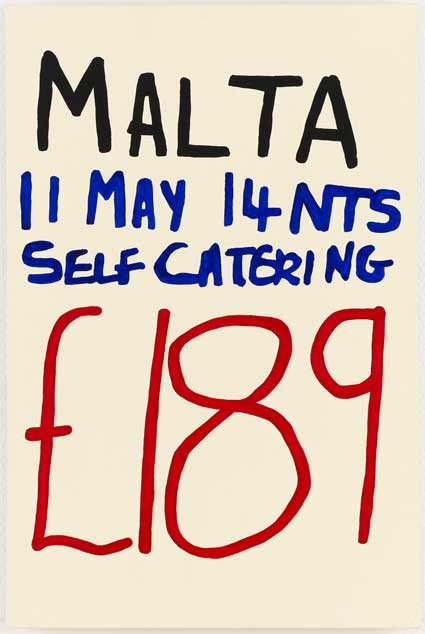
Jonathan Monk, #129, MALTA £189, (From the series: Holiday Paintings, 1992-2000). Photo: Anders Sune Berg, Copenhagen
An increase in the standard of living, affordable air travel and the development of the package tour enabled international mass tourism to thrive. For someone living in greater London, Venice today is almost as accessible as Brighton was 100 years ago.
The World Tourism Organization (UNWTO) forecasts that international tourism will continue growing at the average annual rate of 4 % (at least in places where global warming won’t totally destroy the sector.) As a result international arrivals are expected to reach over 1.56 billion by the year 2020.
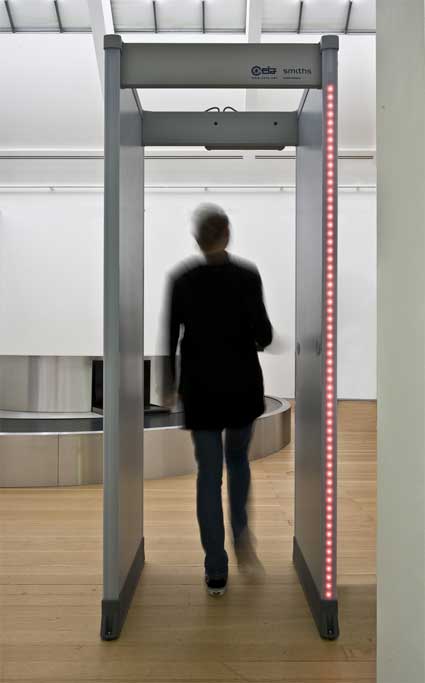
Ayse Erkmen, Safety Doors, 1996-2008. Photo: Norbert Miguletz
The All-Inclusive exhibition opens with 2 artworks which both evokes two of the most unpleasant moments that pave the tourist’s journey: the passage through security with AyÅŸe Erkmen‘s Safety Doors which will inevitably ring as you go through, and the wait for your suitcase with a baggage conveyor belt turning around its own axis by the Scandinavian artist duo Michael Elmgreen and Ingar Dragset .
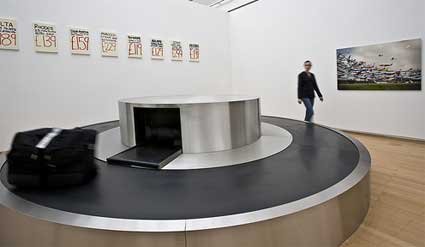
Uncollected (Baggage reclaim) (2005)
Further away, you’re met with another tourist staple: Tensa-barriers that control more than they guide your way along the long long queues. Eva Grubinger‘s Crowd, 2007 is separating one room of the exhibition to another one. There’s no alternative: you have to go through it and feel as foolish as ever.
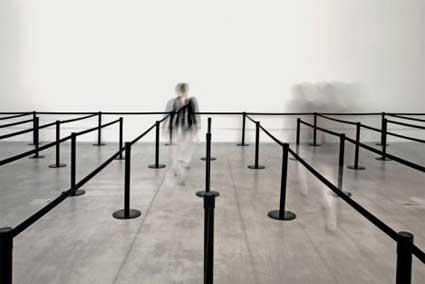
Eva Grubinger, Crowd, 2007. © VG Bild-Kunst, Bonn 2007, Foto: Markus Hawlik
The mood is set, you’re not here to dream and get an overview of the most charming aspects of tourism. And you might exit the show feeling guilty to contribute to the phenomenon. Not that this will stop you from booking a Summer holiday next week.
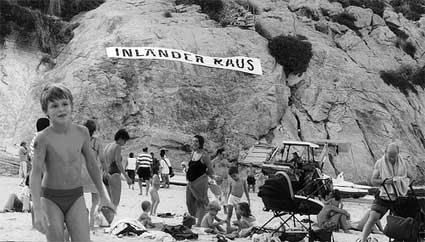
Santiago Sierra, Banner suspended in front of a cove, Cala San Vicente, Mallorca, Spain. August 2001. Photo: Santiago Sierra
One of the most symbolic artworks show in Frankfurt is Santiago Sierra‘s 2001 action on a Spanish beach. In August, the peak of touristic period, he had a huge banner hung from a rock wall overseeing a beach in Mallorca that read “Inländer Raus” (“Natives, go away”), targeting the tension on the resort island between the Spanish residents and the German tourists. out). The work not only inverts the classic xenophobic motto “Auslander Raus” (Foreigners get the hell out), but it also overtly refers to German retirees and celebrities who have virtually displaced the Spanish natives in Majorca.
Responding to complains, the town council immediately ordered the banner torn down, then had it re-installed, and finally it mysteriously disappeared. Soon after the announcement that Sierra had been selected for the Venice Biennale, a series of articles in Spain’s mainstream press attacked the decision, probably because people were afraid the artist might destroy the Biennale pavilion.
The work evokes also the tremendous impact that tourism can have on an entire area. Think of Benidorm, that village turned “the Manhattan of the Costa Blanca”, or of that forgotten city in the Basque city which has become a tourists magnet since its Guggenheim Museum opened in 1997.
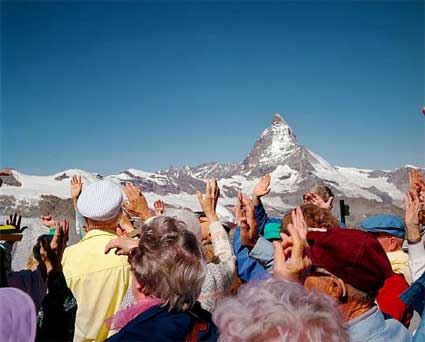
Martin Parr, The Matterhorn, 1990
The number one favourite activity of the tourist is taking picture. There are plenty of those in the show. Not by tourists but by renown photographers. Martin Parr’s (more in Martin Parr retrospective: from fish & chips to mass tourism) depict tourist patterns of behavior frozen to clichés in a Swiss mountain resort.
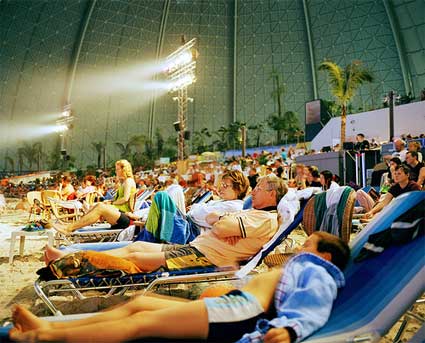
Reiner Riedler, Schilift, 2005
Reiner Riedler‘s lens focuses on artificial tourist landscapes. His photo series Artificial Holidays show people sunbathing on an indoor tropical island in Berlin, skying in Dubai, having dinner at the bottom of Florida’s very own Mexican pyramid are based on similar stereotypes. They confirm the theory that tourist photography mainly serves the purpose of confirmation and not of discovery.
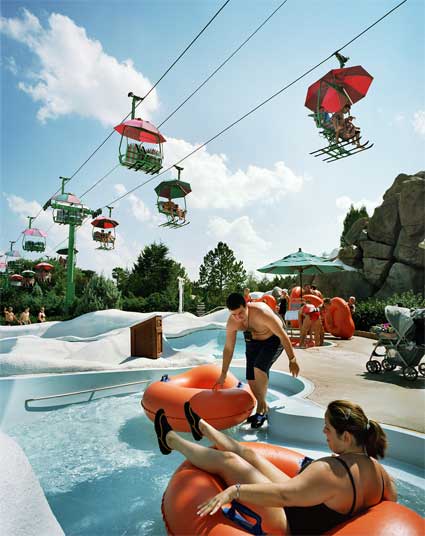
Reiner Rieder, Indoor Pool “Tropical Islands” in Berlin Brandenburg
Thomas Struth’s Museum Photographs show tourists in shorts, jeans and t-shirts with their cameras and guidebooks as they wander around museums with a look on their face that says that no matter how interested they might or might not be in the paintings hung on the walls, they just “have to” be there and be seen contemplating the works. You look at them and find it a bit repulsive then you realize you’re just one of them, no matter how educated and refined you might be. Last year, for example, art travel packets -including flights, car rental, entry tickets and hotel- enabled the enlightened to tour the most distinguished event of the European art Summer: the Venice Biennale, Art Basel, documenta in Kassel, and Skulptur. Projekte in Münster.
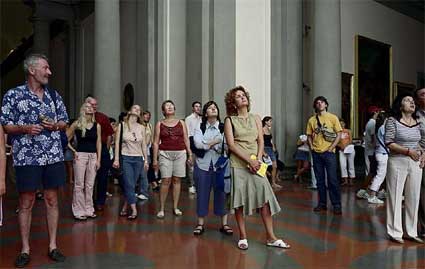
Thomas Struth, Audience 8 (Galleria dell’Accademia) Firenze, 2004
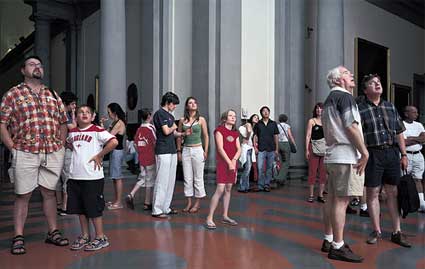
Thomas Struth, Audience 1, Firenze, 2004
NL Architects‘s futuristic scenarios do not forecast a brighter future. In their manipulated images, tourism is used as a weapon by invaders coming to your shores with amusement parks erected on the decks of aircraft carriers.
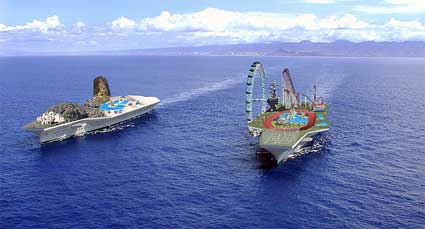
NL Architects, Cruise City, 2003. Courtesy: NL Architects, Amsterdam
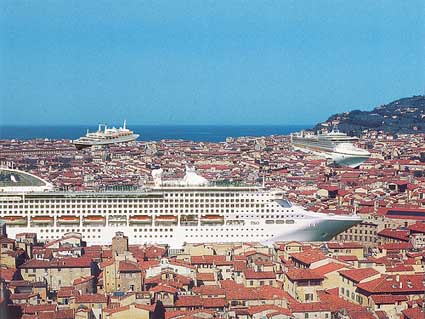
NL Architects, Plugin City, 2007. Courtesy: NL Architects, Amsterdam
Tourism and travels are not just about cultural city trips and long afternoons at the beach, it can also be grounded in political and economic circumstances. The Moroccan artist Yto Barrada has captured this fact in A Life Full of Holes: The Straits Project, her photo series about Tangier and the Straits of Gibraltar. The narrow channel that divides Europe and Africa is a sea basin just 14 km across in some places. It is one of the most traveled waterways in the world, but few Africans are able to cross it. The photos examine the hope of migration, its influence on the Tangier cityscape and the temptations of leaving to begin a new life in the other side of the sea.
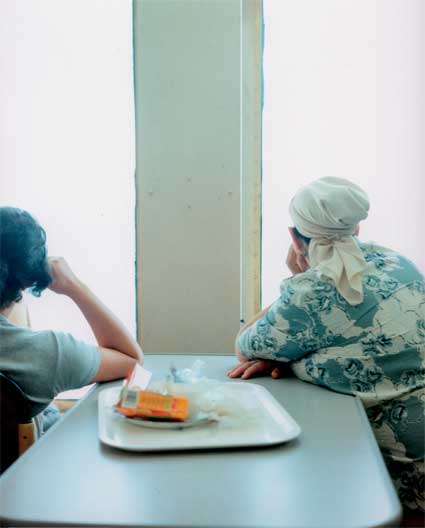
Yto Barrada, Women at Window, 2002. Foto © MUMOK
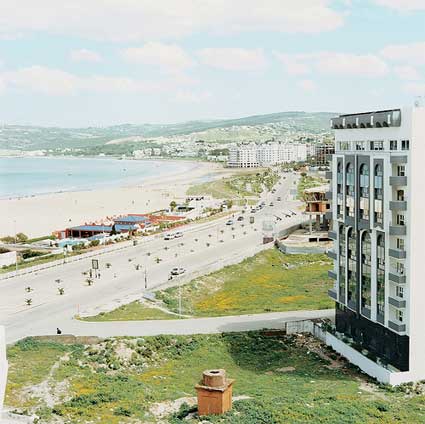
Yto Barrada, Bay of Tangier, 2002 (From the series: The straight project, 1999-2003)
All-Inclusive reminds us that tourism is one of the most powerful economic forces in the world and as such it is one of the hottest topics in the debate over globalization. Tourism doesn’t just bring mouthwatering economic perspectives, it comes with ecological and political aspects: migration, terrorism, pollution of the environment, prostitution, etc.
Both Stern and FAZ have slideshows.
“All-Inclusive. A Tourist World” is on show at the Schirn in Frankfurt from 30 January to 4 May 2008,
Tokyo correspondent Vicente Gutierrez paid a visit to the Yokohama Museum of Art last month to check the exhibition Goth – Reality of the Departed World . Here’s what he has to say about it:
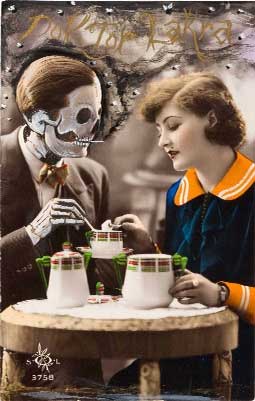
Dr. Lakra, Untitled (Muscidae and Tea), 2007. Courtesy of the Artist and Kurimanzutto, Mexico City
Unmistakably, Goth-culture has emerged from centuries ago back into the fore of 21st century life. While the noir-drenched subculture’s origins are rooted in the aesthetics of the “gothic” art movement which permeated Europe from the 12th to 16th centuries, Goth imagery and iconography and fashion we see today is more connected to the 19th century British revival movement which entertained a longing for medieval times.
The Goth culture of today, found in movies, music, fashion and literature, is influenced more by the revival movement and hinges on darker, yet familiar, concepts of death, darkness or night, abnormality, insanity and just about anything that is opposed to a healthy and conservatively-perceived status quo. And so, the youth, pop-culture as well as contemporary art have been infected with notions of Goth. Whether it be Marylyn Manson’s baroque stadium tours, a noir-revival in film or artists who explore death, deformation of the body or self-identity, these attempts break through the norm of the status quo.
The exhibit at the Yokohama Museum of Art featured approximately 250 works of contemporary sculpture, painting, video and photography by six internationally active artists to cite a new working definition of ‘Goth’ in a contemporary setting.
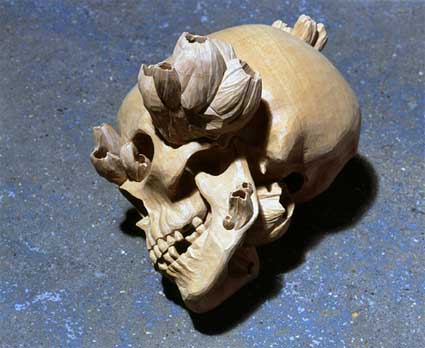
Ricky Swallow, Younger Than Yesterday, 2006
Collection of Ms.Tiqui Atencio Demirdjian
Shown in Japan for the first time, the detailed, wooden sculptures of Ricky Swallow [Australia] juxtapose vanity and death with the use of skull iconography in this work. Even though skull iconography seems to be everywhere as of late, Swallow also displayed a delicately wood carved skeleton with so much invested work that it seemed human. Each bone, while carved and pieced together delicately to replicate the raw, natural human form, echoed of [human] flaws. The composed, docile macabre posed in the center of the room, with an enigmatic chagrin. In addition to his woodcarvings, Swallow’s sculpture of a bronzed vintage boom box further expressed the artist’s concern with the flow of time, whether in cyclical or standstill. To preserve what we love despite beauty’s transience, knowing it will ultimately die, reminds us of the brevity of life and the tragically comforting adage, that nothing lasts forever.

Pyuupiru, Selfportrait #02 A 12-year-old Boy Bearing Scars, 2005-07
Spanning the wall of the exhibit space were Pyuupiru‘s collection of self-portraits which featured the artist with a variety of dramatic, mutilated poses. Appearing androgynous at times, self mutilation and modification were the tools the artist has taken to find her true self in hopes of actualizing her value as a person- psychologically and physically. With the progression of photographs, perhaps Pyuupiru is awaiting a final metamorphoses. How long? Remains a question for the viewer and artist alike. Here, the photos are said to present the process of transformation from man to woman and from a monster to a total self. The incision, modification and mutilation of her physical self seem not to deflect her bold and persistent gaze at the camera- what appears fragile on the surface is not. Rather, in exploring her self identity, her search for true-self is nihilist although a longing for a perfect love of self is detectable.
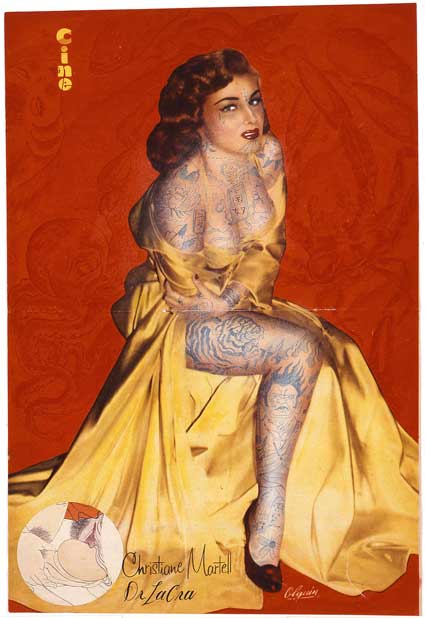
Dr. Lakra, Untitled (Love, Christiane Martell), 2007
Courtesy of the Artist and Kurimanzutto, Mexico City
Comfortable in his technique, tattoo artist Dr. Lakra [Mexico] used vintage Mexican magazine covers (featuring pin up girls and wrestlers) as canvas for his permanent ink. While some of his exhibited works were completed during his residency at the Yokohama Museum of Art Common, Lakra’s concerns with death led him to rely on dark iconography such as demons, bats, insects, spiders and gothic patterns which are intertwined with the beautification of the very figures he draws upon. The darker image of Lakra maintains as beautiful literally overwrites original perceptions of these vintage cover models; shunning the original conventions. Lakra’s subversive obsession with kitsch beauty and death is perhaps strongly correlated to his up brining in Catholic-heavy Mexico, where such conservative ideas pervade. Continuing to mix the sacred and the secular, Lakra’s resistance to an overarching conservatism is clear.

Masayuki Yoshinaga, Goth-Loli (Gothic Lolita), 2006
Masayuki Yoshinaga’s [Japan] massive archive of street photos of modern day Goth youth, reveal the culture’s current vitality. In this collection of photos, Goth iconography is seen translated in a variety of ways- the lolita dresses pervade, as does heavy, aesthetically-driven make up in addition to teeth actually sharpened into a set of fangs. Another stronger body modification, for the truly committed goth, were triangle slits into tongues for a vampire or serpent effect. Yoshinaga’s lens focuses on the more colorful and vibrant tangent off the Goth tradition- youth who’s obsessive concentration on their subculture suggests a darker, clouded periphery. That is, all else, i.e. values of the status quo, are meaningless. In order to capture such vanity, Yoshinaga elects subjects who wear their heart on their sleeve, no matter how dark it may be.
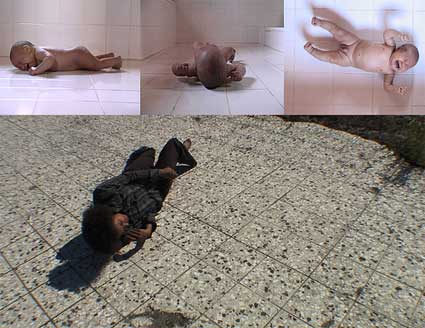
IngridMwangiRobertHutter, Performance of Doubt, 2007
For this exhibition, a new video installation was created around the theme of human life, which the artists symbolized through birth, maturity and aging. One video, focused on multiple angles of an infant, simply laying on a cold, tiled floor unable to move or walk. In its peril, the infant managed roll over, all the while crying, for some kind of salavation. Is there something beautiful in this or do we file it under morbid? Concerned with conditions of human existence, IngridMwangiRobertHutter‘s videos provide introspection into moments we opt, and opt not, to remember or avoid confronting but nevertheless expected in our life span. Moreover, how do we deal with the violence, injustice and consequent endemic suffering in our world? Other projected clips focused on an older individual going through suffering, as if surviving a failed suicide attempt from a buildling as well as an elder patient anxiously awaiting in a clinical room.
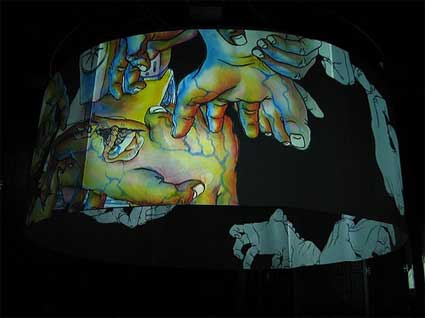
Tabaimo, Ginyo-ru(guignoller), 2005
Courtesy of the Artist and Gallery Koyanagi. Photo: Ufer! Art Documentary
In a darker room, Tabaimo’s large format 360 degree video installation, raised to the ceiling, presented an inner imaginative world where severed hands and feet floated in an interstitial space within the circular canvas. The looped animated sequence revealed a fluid morphing and mutilation of body parts into and out of each other. More fascinating than disturbing, closer attention to the enigmatic evolution of the floating limbs, garnered Tabaimo’s individual aesthetic as an animator.
From this collection of contemporary works, Goth is clearly moving onto a wider platform. It is not only the style or the fashion, but rather a means to communicate profound ideas of life, whether those be painful or sorrowful or morbid, they are messages with the same importance and relevance of those found in pop art, or other avenues of pop culture. And on such a platform, these contemporary artists will continue their reflections on birth, death and the transformations that come in between.
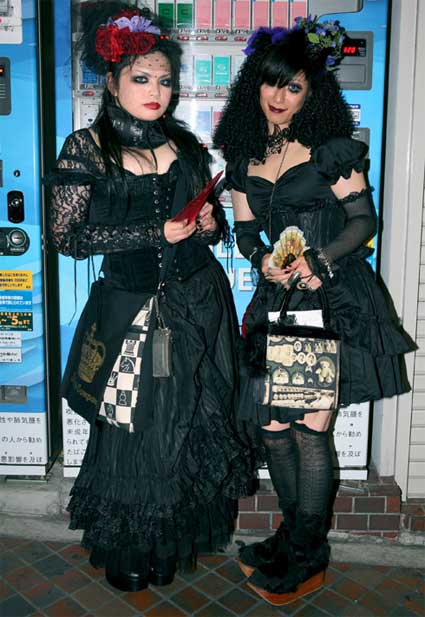
Masayuki Yoshinaga (more images)
Today people will look down on you if your art space doesn’t have an exhibition dedicated to ecological issues on its agenda. Unsurprisingly, Milan still hasn’t organized anything worth mentioning but her little neighbour, the enlightened and chilly Turin, did. The show is called Greenwashing. Environment, Perils, Promises and Perplexities and is on view at the Fondazione Rebaudengo until May 11, 2008.
Here’s the premise: The diverse practices represented in the exhibition do not just point the finger at the degradation of our planet, they also make more tangible the contradictions and responsibilities that we encounter personally and as a society. Art here does not necessarily proclaim a ‘correct’ ethical or green choice, but allows the possibility for broadening and analysing our perceptions and actions.

Ettore Favini, Green is the Color of Money, 2007
The 25 artists and groups selected not only engage with emissions’ offsetting, food miles, environmental marketing, ecological footprints, and other eco-conscious issues but they also bring attention to their political and social consequences. Many of the works selected are extremely good at making environmental issues less abstract and remote from our daily reach. I’m glad i had the opportunity to see all these pieces in one go. That’s what thematic exhibitions are for, right? However, i couldn’t see much past the simple gathering of works, they have this environmental streak to keep them together but there is something missing in the curatorial vision. I don’t know the secret to curating an exhibition with a scope and breath which will go beyond the sum of all the works it gangs around but it sure is puzzling when the multiplier symbol is missing.
Still, this exhibition provides enough food for thought for people who are naive enough to believe that they can sleep soundly in their organic cotton bed linen just because they recycle glass, never print any paper unless they have no other choice and always bring their own bags to the supermarket.
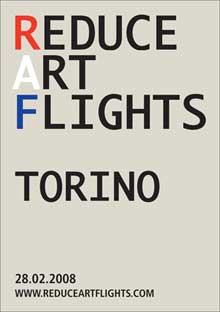 I, for one, can say proudly that i only drive bikes (i don’t have a driving license anyway) but when i saw the posters of RAF / Reduce Art Flights i could only laugh out loud at my own candor. I might not own a Hummer but i take an awful lot of planes for my work.
I, for one, can say proudly that i only drive bikes (i don’t have a driving license anyway) but when i saw the posters of RAF / Reduce Art Flights i could only laugh out loud at my own candor. I might not own a Hummer but i take an awful lot of planes for my work.
Initiated by Gustav Metzger, the RAF campaign upholds that the art world – artists, curators, critics, gallerists, collectors, museum directors, and art bloggers too i guess – could or should swap planes for less carbon dioxide-emitting transports.
The RAF acronym deliberately echoes the Royal Air Force – the aerial warfare branch of the British military – as well as the militant left-wing group known as the Red Army Faction. The message is communicated by mass-produced leaflets first distributed during Sculpture Projects M??nster last Summer. The Turin version of the leaflet is available in art galleries and inserted into international mailings in connection with the exhibition.
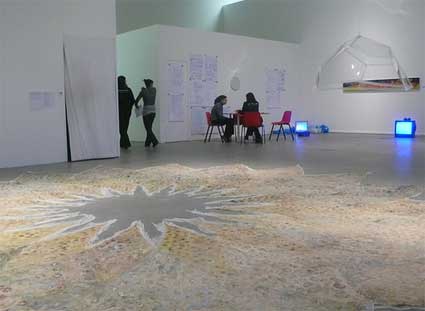
View of Beyond Pastoral (Shroud of Turin) at the Rebaudengo
BP’s environmental record is pretty appalling. In 2000, British Petroleum changed its name to BP (Beyond Petroleum) and chose a yellow and green sunflower-like as its logo in a bid to highlight its interest in alternative and environmentally friendly fuels. Nevertheless BP was named one of the “ten worst corporations” in both 2001 and 2005 based on its environmental and human rights records.
The Bruce High Quality Foundation‘s installation Beyond Pastoral (Shroud of Turin) grows out of a project that the BHQF initiated for an exhibition in New York in 2007, which consisted of a 1/5 scale model of the BP petrol station located opposite the gallery, underneath which thousands of lemons and limes were arranged in the form of the BP logo.
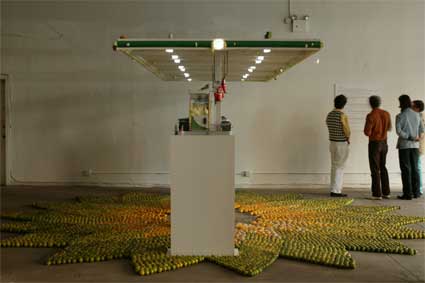
Installation in New York. Photo Oto Gillen
Each fruit was wired with electrodes and together they generated enough electrical current to illuminate the model. The irony of this seemingly earnest demonstration of an alternative energy source lies in the fact that the citruses quickly started to rot, posing a health hazard. Besides, transporting the fruit had required hundreds of liters of fuel. The Turin version of the work presented only the beautifully parched carpet of lemons and videos documenting the New York installation.
A few weeks ago, i was in a museum bar in New York and almost fell of my chair when i was served a bottle of San Pellegrino, a water that (i think) comes from Lombardy in Italy. Minerva Cuevas‘s installation in Turin echoes our absurd and eco-damaging fetishism for “exotic” waters.
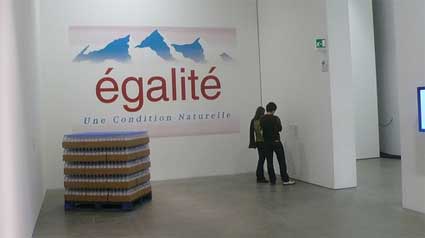
??galit?? (2003) also involves the sabotaging of a corporate graphic identity. Owned by the Danone group, Evian is probably the world’s best-known bottled water. Considering that the global market for bottled water multiplied more than 1000 times in the last decade – its average price is more than that of petrol – Cuevas has kept the shape and design of the bottle intact. Bar one detail: she replaced the familiar brand’s lettering by ??galit??, as in France’s motto, ‘Libert??, ??galit??, fraternit??’ (Liberty, equality, fraternity), subtly pointing out political issues linked to water throughout the world nowadays.

There is little equality as far as access to water is concerned, and those who have a seemingly unlimited access to it would rather pay ridiculous prices for something that comes almost freely from a tap.
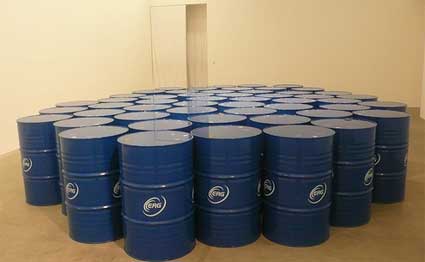
Wilfredo Prieto‘s Estanque installation is a congregation of crude oil barrels choreographed to look like an idyllic lily pond habitat complete with water puddles and a live frog (which had left the building when i visited the show).
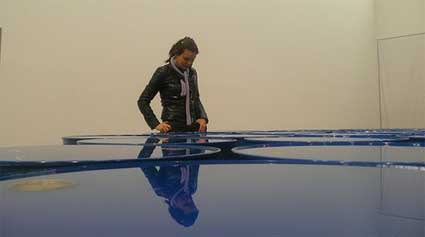
I’m the little frog on the oil pond!
Petroleum oil, which is itself an organic substance, is converted by the sheer iconic power of its container into a symbol of all of the ills of our fossil-fuel dependency. Yet the sculpture inevitably suggests the prospect of eco-advertising, as if its graphic visual summary of apparent amphibian-petroleum harmony could perfectly lend itself to an audacious company marketing department in a bid to demonstrate their ‘green’ industrial principles.
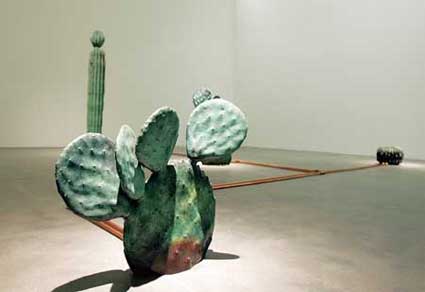
Simon Starling‘s ironic C.A.M. Crassulacean Acid Metabolism belongs to the artist’s fascinating series of “cactus works.” This installation is made of functioning cast iron radiators shaped like cacti and connected to a boiler with copper piping. The title of the work comes from a biochemical pathway that is a complex variation of photosynthesis, whereby some plants acquire carbon dioxide during the hours of darkness, minimizing thus eco-physiological stress and water loss from their leaves by avoiding gas exchange during the hot part of the day. C.A.M. opposes the supremely efficient and economical cactus strategy with the slightly ludicrous man-made radiators that expel heat into the exhibition space.
Jennifer Allora and Guillermo Calzadilla, whose life-sized clay hippopotamus had charmed me so much at the Venice Biennale in 2005, presented photos that document a participatory performance event they staged on the island of Vieques in March 2003 together with local residents and activist groups protesting against the U.S Military occupation of the island. The U.S had bought the land from the Puerto Rican government and had been using it for military exercises, and as a firing range and testing ground for bombs, missiles, and other weapons. The military experiments brought together with them severe ecological damage.
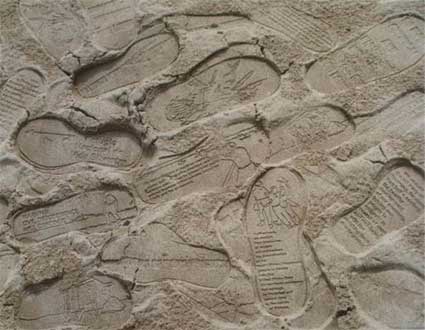
Jennifer Allora & Guillermo Calzadilla, Land Mark (Foot prints) #2, Set II, 2001-2004
Allora & Calzadilla designed rubber shoe soles to be worn during actions of protest. When activists illegally entered the bombing range, they left behind indented messages for the US military staff. The imprints were a way of reclaiming the disputed territory, giving new power to the term “landmark.”
Today the contested territory, though still contaminated and debated, is a wildlife reserve under the protection of the US Fish and Wildlife Service.
Verdict: Greenwashing is a moving exhibition worth taking the train for if you ever come to Milan this month for the Salone del Mobile. I’m sure there will be some inspiring projects and gadgets presented this year at the international furniture fair. I wonder if any of them will have the strength of most of the artworks i discovered at the Fondazione Rebaudengo the other day.
I went camera-crazy again.
GREENWASHING will run at the Fondazione Sandretto Re Rebaudengo centre for contemporary art in Turin, Italy through 11 May 2008.
Related: Book review: Worldchanging: A Users Guide for the 21st Century; Ecological Strategies in Today’s Art (part 1 and 2).
Previously at the Fondazione Re Rebaudengo: Murakami exhibition in Turin.
Image on the homepage: Amy Balkin, Public Smog, 2004.
The Centro Andaluz de Arte Contemporaneo in Sevilla is currently running an exhibition dedicated to Ant Farm, a group of experimental architects and critical artists active mostly in the ’70s. The exhibition includes videos, models, original drawings, inflatables and all the quiet you can expect in a cultural center located inside a stunning monastry on the bank of the Guadalquivir River, the Monasterio de la Cartuja de Santa MarÃa de Las Cuevas.
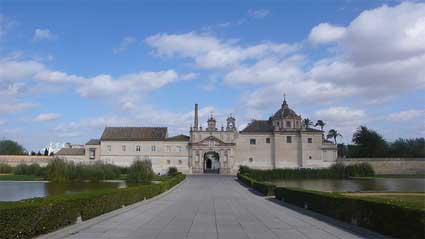
Monasterio de la Cartuja de Santa MarÃa de Las Cuevas
Founded in San Francisco in 1969 Ant Farm could be regarded today as a very effective mix between Archigram, the Rolling Stones and The Yes Men. Ant Farm embraced the latest technologies at the same time as they hit American culture on the head with their social and political comments and their highly critical (up to being in some cases destructive) approach to mass media. Their projects do not stop at the work of art itself, they also encompass the mass media rendering of that work of art.
All i knew about them was their rusty Cadillac Ranch installation which i do not like very much but the rest of their practice impressed me beyond words. I can’t think of any artistic group playing a similarly brilliant, innovative and multidisciplinary work today. Here’s a shortcut to their works:
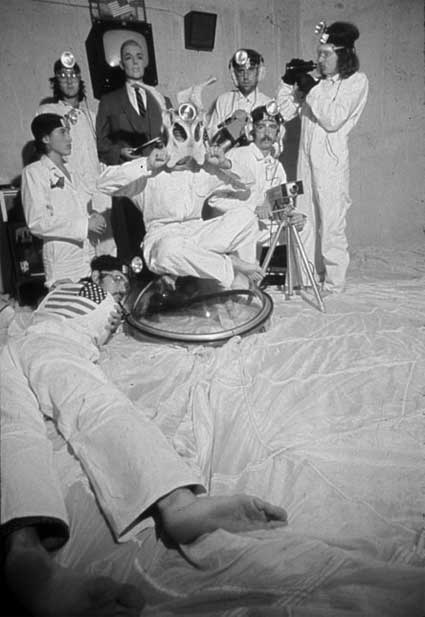
Ant Farm, Space Cowboy Meets Plastic Businessman, 1969. Performance at Alley Theater, Houston
Ant Farm deployed their conceptual world through videos, manifestos, spectacular performances and installations until 1978, when they disbanded following a studio fire. Most of the slide and video documentation was saved, but very little else survived.
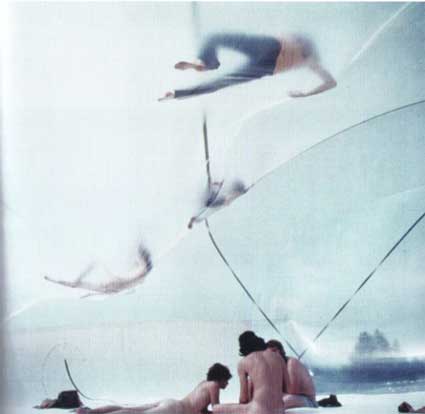
50×50 Foot Pillow, used as a medical pavilion at the Rolling Stones free concert at Altamont in 1969
Ant Farm started their career as evangelists of inflatable structures. Cheap and easy to assemble, they challenged the American consumerism culture and fitted perfectly a nomadic, communal lifestyle, in total contrast with the Brutalist architecture prevalent in the United States during the 1960s.
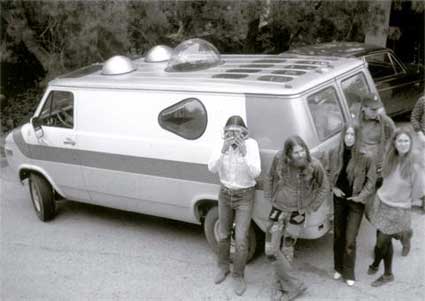
In 1971, they took the road abroad their Media Van, a customised Chevrolet van turned into a mobile studio to share information and images with the public while they toured the country to give talks and organize public happenings. The van not only transported the material necessary to build their ICE 9 inflatables but its motor was also used to generate the energy indispensable to blow up the structure.
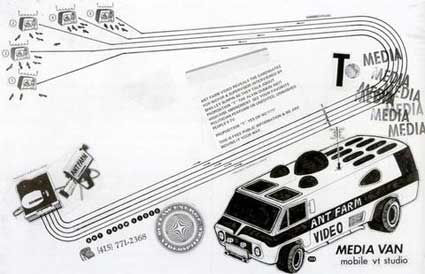
In 1972 the group built in Texas the House of the Century, a ferro-cement weekend residence with organic shapes that remind the inflatable structure that Ant Farm had realized a few years earlier, in particular their ICE 9 prototype.
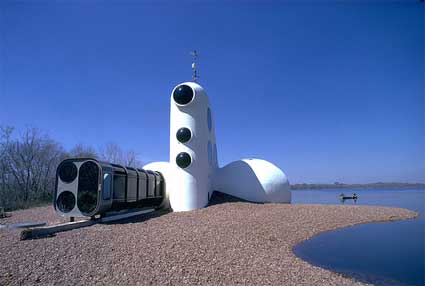
House of the Century, 1972
Video showing what the House was like before its decay:
The Dolphin Embassy was a never realized sea station in Australia which engaged with interspecies communication using the new video technologies. The structure would sail with the help of a solar mechanism.
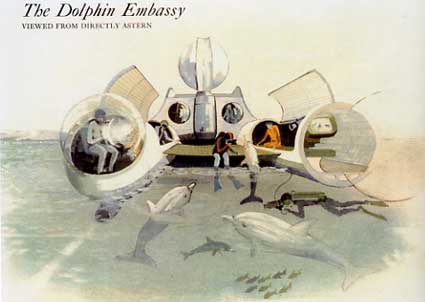
In 1974, Ant Farm created their most famous pieces in Amarillo, Texas, Cadillac Ranch. They half-buried a row of used and junk Cadillac automobiles dating from 1949 to 1963, nose-first in the ground, at an angle corresponding to that of the Great Pyramid of Giza. To add to the outrage done to the iconic vehicle, the public is very welcome to graffiti the cars.

Image wikipedia
The installation was originally located in a wheat field, but was later moved 3 kilometers to the west, to a cow pasture in order to place it further from the limits of the growing city.
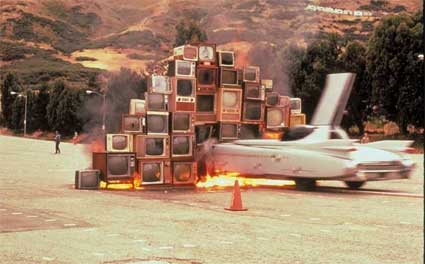
A year later Ant Farm staged the performance Media Burn. Dressed as astronauts, they drove at full speed a 1959 Cadillac into a wall of burning television sets. Media Burn critiqued American ideals of heroics and technological superiority, and offered an affront to the television media who were the only one invited to attend the event.
Their video of the performance is styled after news coverage of a space launch, including melodramatic pre-stunt interviews with the artists and a speech by “JFK” (impersonated by Doug Hall).

Short video and a 26 minute one.
Media Burn was not their first attack of the media, in 1972 they collaborated with the video collective Raindance to launch the guerrilla Top Value Television (TVTV) to provide alternative coverage of the political conventions of that year.
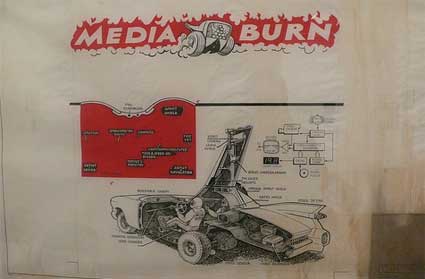
Let’s close the post with The Eternal Frame, a 1975 reenactment of the John F. Kennedy assassination. Part of it plays on America’s obsession with the media, but the video demonstrates also that the sacred images of the assassination cannot be mocked. The work can be read as a commentary on the pervasive media culture in America, as it explores how the Kennedy assassination itself became a new type of media event.
Video:
More images.
The exhibition of Ant Farm’s work is on view at the CAAC in Sevilla, Spain, until June 8, 2008.
Actar has just released Ant Farm – Living Archive 7. Felicity D. Scott has collected archival material to illustrate the early trajectory of the collective, including its architecture, inflatables, performance, multimedia, and video work.
Nice, nice. I’ve lost my connecting flight and now i’m stuck in Madrid Barajas waiting for the next flight to Sevilla. It’s an 8 hour wait but i’m on my way to ZEMOS98 so i am still cheerful.
Anyway, gives me plenty of time to catch up with the emails and the long overdue posts. So back to New York where i was a few days ago and the Exit Art gallery. I’m still wondering how this place managed to escape my radar so far.
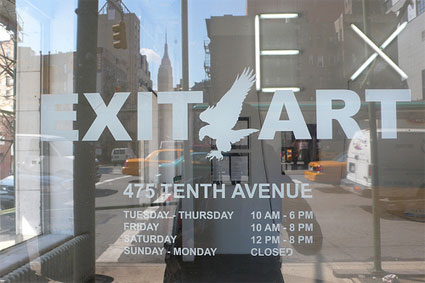
Until April 19 they are running a fascinating exhibition on artistic explorations of the current advancements in neurological research. The works shown in BRAINWAVE: Common Senses encourage visitors to consider the brain not only as the center of human activity but as a site for interpretation, for scientific and philosophical debates, for examining our relationship to the world – and for questioning our common sense.
I am usually not very excited by media art works which engage with the little grey cells. Blame it on the BrainBar, when i discovered it i somehow felt that had seen it all. Well, maybe not… I went to Exit Art to see Fernando Orellana and Brendan Burns’ robot that “plays back dreams” which was twice as fantastic as i expected but i also discovered 2 or 3 outstanding works.
Suzanne Anker‘s fascinating and elegant The Butterfly in the Brain uses three-dimensional Rorschach inkblot tests, brain scans and images of butterfly wings to explores the imagery of the symmetrical (or virtually symmetrical) structures of butterflies, the brain, and chromosomes.
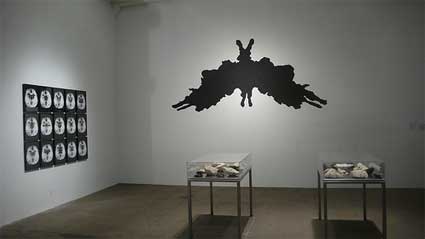
I somehow can’t get the black hovering butterfly bat she painted on the wall out of my mind. “By taking the butterfly bat image out of a textbook, scaling it up to a large size, and putting it in a site-specific environment, one turns the image into an entirely new and other kind of affective entity,” she explained.
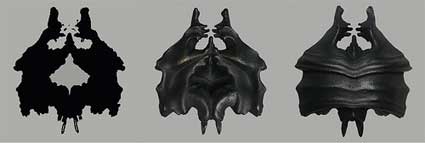
Suzanne Anker, The Sum of All Fears (detail). Image courtesy of the Exit Art gallery
Although the use of Rorschach inkblots is controversial in psychology, the images are widely recognized among the public.
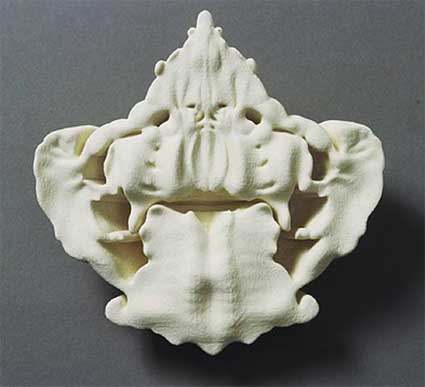
Crab, 2005
Anker used a computer program to convert an inkblot into 3D structure so intricate they could probably not be re-created using traditional sculpture. After which a machine produces the object using plaster and resin. “Looking in 3-D,” Anker argued, “one begins to assess new meanings: bones, sea creatures, body parts. These are surrogates for the imagination itself, opening up a dialog between the mind and body. What happens when you can pick up a psychology test in your hand? The mind essentially has been embodied.”
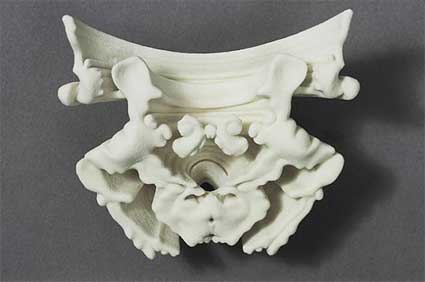
Gossipers, 2005 (more images)
She also transposed butterfly wings onto MRI scans, drawing a parallel between genetic patterns in nature and advanced imaging technologies. Like constellations in the sky, butterfly shapes may be found in neurological maps as well as charts of urban sprawl.
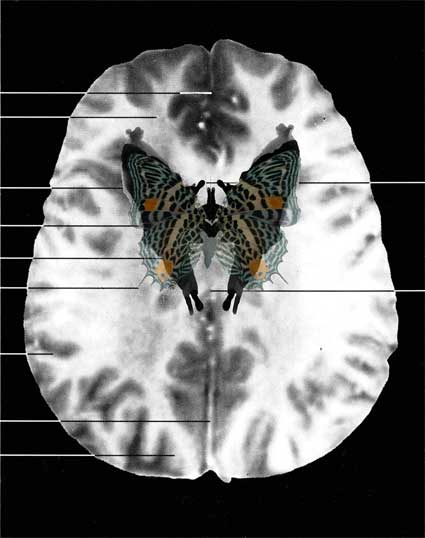
Suzanne Anker, MRI Butterfly (detail). Image courtesy of the Exit Art gallery
Another work i found really moving and riveting was a video installation by Phil Buehler, a photographer, fascinated by “haunted ruins” of abandoned Psychiatric Hospitals.
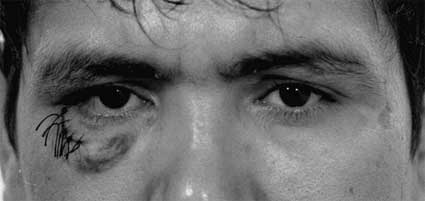
Buehler, Windows of the Soul. Image courtesy of the Exit Art gallery
Windows of the Soul, asks whether or not one can read madness in another’s eyes. 300 b&w mug shot photographs of mental patients, taken in the ’50s when they were admitted in the hospital. The eyes of the individuals are projected on a canvas hanging from the ceiling. The rest of the face lays on the floor. Every 5 seconds, another pair of eyes and a face take their place on the split screen. Riveting and disturbing.
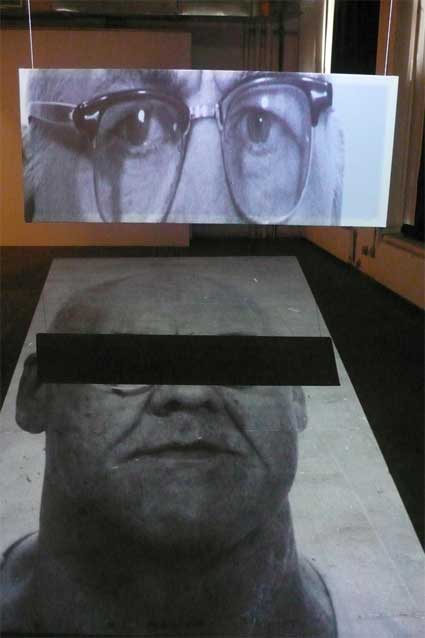
Dustin Wenzel‘s brass sculptures are brain-cavity castings of Great Whales from the New Brunswick Museum collection.
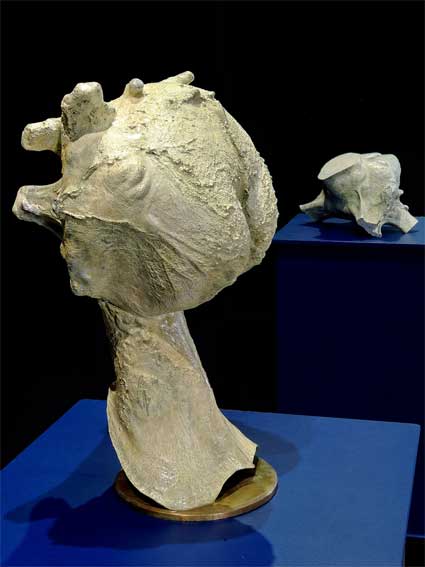
Dustin Wenzel, (front) Sperm Whale Endocranial Cast, (back) Right Whale Endocranial Cast. Image courtesy of Exit Art Gallery
It has recently been discovered that some humpback whales have spindle neurons, a type of brain cell previously considered to exist only in dolphins, humans and other primates, which may indicate a high capacity for intelligence. Although white males possess the largest physical brain of any animals (Wenzel’s castings were indeed impressively big), there is no scientific consensus about the nature, magnitude or even existence of cetacean intelligence.
And now for the gizmos:
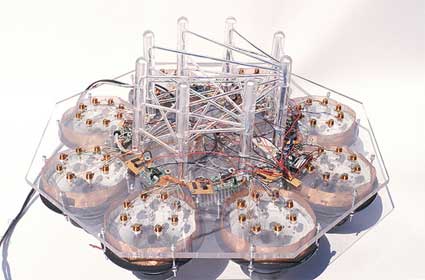
Jamie O’Shea, Alvin (image courtesy of Exit Art gallery)
Artificial neural networks are often used in voice recognition systems and IA research. They consist in mathematical computations that mimic the neural network patterns of the nervous system. Jamie O’Shea‘s Alvin is a realization of an interactive and electronic neural network constructed with physical hardware. When left alone Alvin is dormant, but if you the lay your hand on the interface provided, you will set an electronic neural-like network in motion.
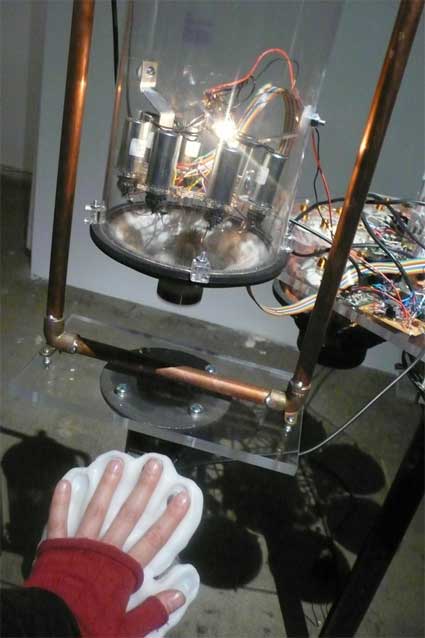
Alvin is a cellular automaton organized around eight cells which produce sound. The sound one cell produces is determined by what sound the other cells are making. This interrelated input and output scheme is an artificial neural network; a simulation of a brain. The imitation of life goes even further, because Alvin’s sound circuits are built and destroyed by one another, rather than just turned on or off.
Swarm, by David Bowen (whom i interviewed a year ago), is an autonomous roaming device whose movements are determined by houseflies housed inside the device itself.
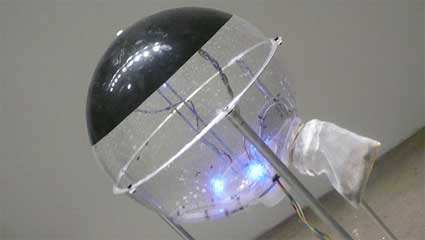
David Bowen, Swarm (detail). Image courtesy of Exit Art Gallery
The chamber where they live contains food, water and light to keep them warm but also sensors that detect the changing light patterns produced by their movements. The sensors send the light data to an on-board microcontroller, which in turn activate the motors moving the device in relation to the movements of the flies.
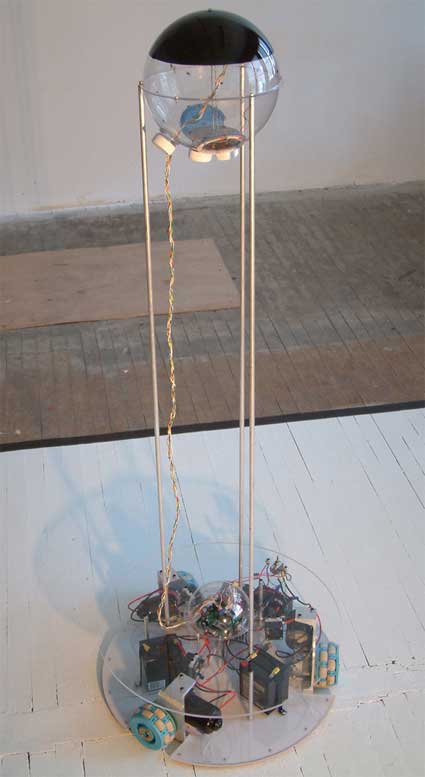
David Bowen, Swarm. Image courtesy of Exit Art Gallery
Oh, look! i took all those little images.
BRAINWAVE: Common Senses is on view until April 19, 2008 at Exit Art Gallery in New York. This exhibition is part of Exit Art’s Unknown Territories series of exhibitions that explore the impact of scientific advances on contemporary culture and examine in particular how contemporary artists interpret and interact with the new knowledge and possibilities created by technological innovation in the 21st century.
10 days ago, i was in Ghent for the festival The Game is Up! at the Vooruit. Artists who study the relationship between art and consumerism were invited to perform, and present their work to explore this year’s theme: Art for Sale.
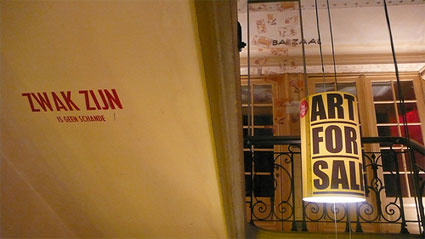
Vending machines, installed all around Vooruit magnificent 1913 building, were packed with surprise objects made by the artists who participated to the exhibition: t-shirts, 5 euro banknotes inside blank envelopes, badges, crazy eyeglasses to see what is happening behind your back, etc.
Eva De Groote had invited me to moderate a couple of Fricties Salons. That’s how i finally got to have dinner with one of my heroes, Heath Bunting, saw a performance of Reverend Billy from the Church of Stop Shopping, had drinks and a lot of laughs with the smart and hilarious Christophe Bruno and the guy who resuscitated net.art Carlos Katastrofky. Definitely one of the most exciting events of this year for me (so far). Bliss-a-lujah!
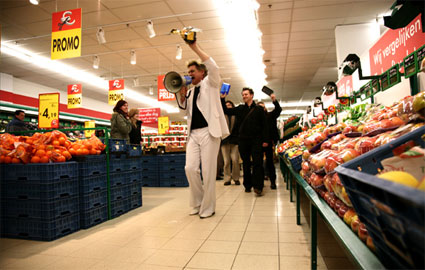
Photo indymedia
On Saturday March 8, i was walking on a cloud telling myself what a lucky person i was to present a FrictiesSalon with the masked and magnificent guys of the Billboard Liberation Front.
Not that it has been a piece of cake. How do you introduce people who should not be introduced? Who have to keep their identity secret in order to be able to keep on doing their own activities? All i could find in the press were stories about the CIA or Mafia like secrecy that surrounds them and implies that “Spouses and friends do not know that the members are in the organization.”
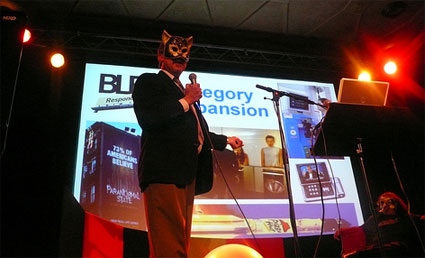
“Improving outdoor advertising since 1977” is the catchphrase of the Billboard Liberation Front. The idea is simple: by making small adjustments to billboards, the BLF creates ironic and often highly critical street marketing campaigns. By changing just a few or sometimes only one letters, they turn upside down the clean and seemingly well-controlled facade of an entire company.
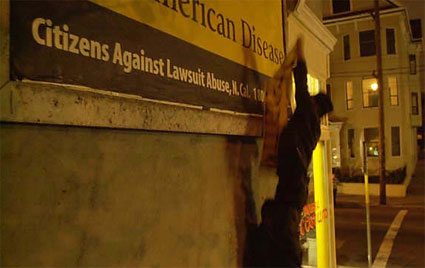
Photo by Gina Gayle for the SF gate
BLF has several sets of presentations. They could have gone for the “terrorist” version but given the theme of the festival, they chose the “corporate” one.
First, we were given a tour of the Fundamentals of the organization, its clients and the opportunities.
They started their actions 30 years ago. At the time, there was no internet, no mobile phone, no blogs, etc. It was also a time when advertisement communication just went one way. Consumers received it and didn’t have anyway to hit back through blogs or forums. There has been dozens of members over the years, some have gone, others have arrived more recently.
Client portfolio
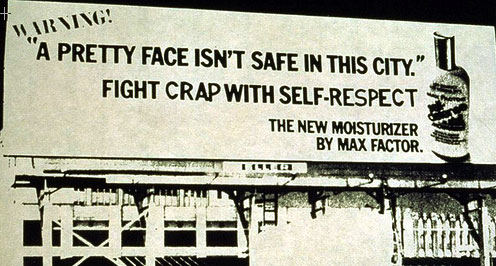
In 77 a “bunch of freaks” in San Francisco called the San Francisco Suicide Club had vowed to live each day like it was the last one. 27 of them (including ten members wearing gorilla suits) were blindfolded and taken up to a roof. They were faced with two Max Factor billboard and some paint. Unfortunately they were a bit drunk, a bit conspicuous because of the gorilla suits and they started arguing about what should be done with the billboard. Some neighbour called the police and SF Suicide Club learned the message the hard way: be prepared, don’t get drunk, don’t wear stupid suits.
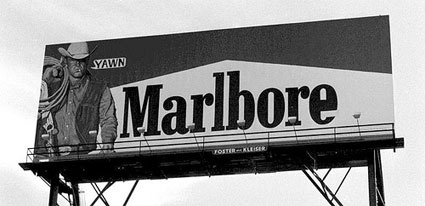
1980. Marlbore instead of Marlboro. It was the first time that the prank was interpreted as a real message from the tobacco company while in fact BLF wanted to comment on the lack of originality of the billboard.
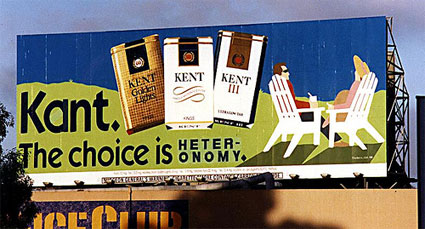
1989. Kant, probably done by a student intern. “Actually it was probably a European intern as no one in the U.S. has ever heard of Kant.”
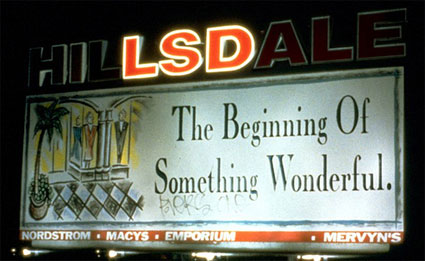
1994. an ad for the the Hillsdale Mall. Very straighforward operation, all they had to do was turn a couple of lights off and just keep the central letters: LSD.
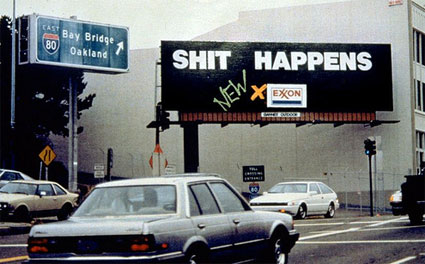
Only a few months after the Exxon Valdez oil spill, one of the most devastating man-made environmental disasters ever to occur at sea which occured in Alaska in 1989, the BLF turned HITS HAPPEN — NEW X-100 into SHIT HAPPENS — NEW EXXON
Then they became more ambitious:
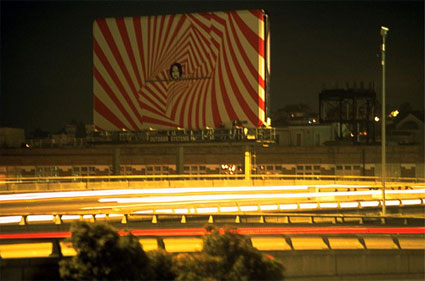
1997. Alteration of a Levi’s billboard overlooking a major highway. BLF issued a press release in which they introduced Charles Manson, a figure who didn’t need any introduction, as the new corporate spokesman of the jeans’ company. This historic collaboration between two of most potent iconic forces of the 1960’s taps into a frothy zeitgeist of manipulative nostalgia.
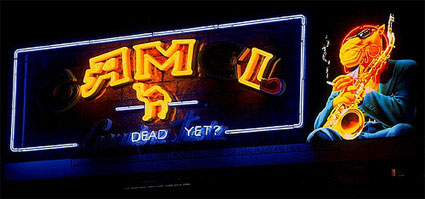
1996. Am I dead yet? Technically more elaborate as they had to sub-contract an electrician and a neon guy.
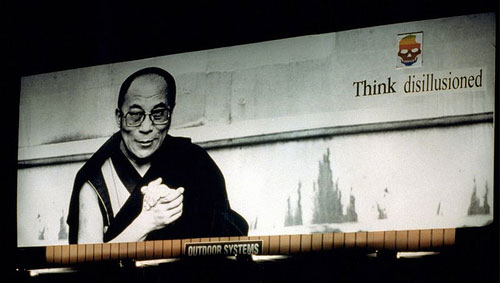
1989. The “Think Different” campaign of Apple became “Think desillusioned”. The company had appropriated the image of famous dead guys or exiled ones like the Dalai Lama. Bulletins are the biggest and the most expensive.
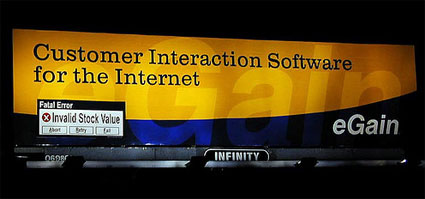
The clients this time were technology companies, with a sector focus on the “dot-coms”. Large-format warning labels were added to the billboards, in the style of a standard computer error message, bearing the bold copy: “FATAL ERROR – Invalid Stock Value Abort/Retry/Fail”.
Ironically the stock market crashed right after this action.
A billboard manipulation can take from a few hours to a few weeks for the most ambitious actions.
Even before the improvement action takes place there is a careful preparation. The area surrounding the billboard is mapped, looking for the best ways of quick escape, ideal positions for ground crews, etc.
BLF has to go more and more tech-savvy, just like the industry does. Today you get talking billboards, talks of billboards in space, billboards activated by motion sensors, etc.
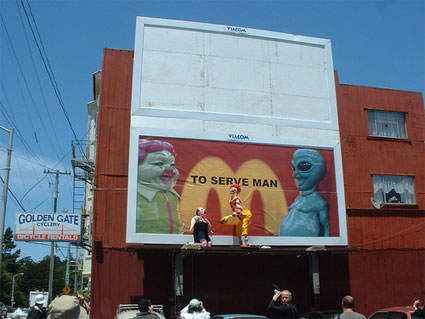
In 2005, they collaborated with artist Ron English for their first animatronic billboard alteration. The background is an original 12′ x 22′ painting by English. At the foreground the animatronic of Ronald McDonald feeding a fat kid his daily dose of Big Macs. The improvement took place in broad day light at a busy cross road in San Francisco while 15 persons where on the ground, dressed up like McDonald and acting crazy.
Some of the key rules of their billboard improvement actions:
– Make alterations that will make people smile not something that will make them angry,
– Less is more. The best improvements are those that require only to alter a single letter to change the whole meaning of the campaign.
– Expose what is hidden. Some advertisers are too shy about what they really mean, BLF will help them make their message clearer. Case in point: the 2005 improvement of Johnny Walker where “Drink responsibly” became “Drink yourself blind”.
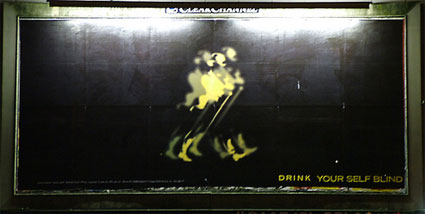
– Send the press some media releases to better disseminate the action. A modified billboard might remain only one hour in the street before it is removed but its traces remain forever online.
– Document your action with some Before and After images.
– A careful planning is essential: Don’t get caught, don’t get hurt. The larger the billboard, the higher you’ll fall.
– Minimize property damage and respect the sign men. BLF make modification which are easy to remove and always leave some beer or liquor for the men who have to come and clean their “improvements.”
– You don’t have to be in San Francisco to make and see billboard improvements. Make yours with the help of BLF’s The Art & Science of Billboard Improvement guide (PDF).
And just like Rev. Billy did in a local shopping center, BLF made their own billboard improvement in the streets of Ghent.
More images of their actions.
Last week i flew to one of my favourite cities, Liverpool, to visit the Sk-interfaces exhibition at the FACT art center. The show, curated by Jens Hauser, explores, materially and metaphorically, the concept of skin as a technological interface.
A controversial new exhibition on display in Liverpool showcases real skin tissue in sculptures wrote the BBC news website. Yet every single person i spoke with during the 2 days i spent in the city didn’t seem to find the show controversial. Interesting, surprising, fascinating, challenging, thought-provoking, worth bringing my mum, etc. That’s what i heard but no one i talked to seemed overly shocked nor disturbed.
There is material to cause quite a stir in sk-interfaces but Liverpudlians seemed to be more concerned by the issues brought to light by the artists than by the potentially seditious or “freaky” character of the works on show.
I’ll start the blog visit of this multi-disciplinary exhibition by walking to the second floor of FACT.
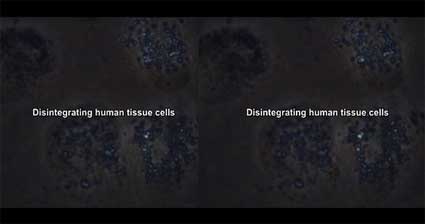
Critical Art Ensemble, Immolation. Image courtesy of the artists
Immolation is a video installation concerned with the subject of the use of incendiary weapons on civilians after the Geneva Convention and the Protocol on Prohibitions or Restrictions on the Use of Incendiary Weapons of 1980. The USA have refused to sign the convention and they make regular use of firebombs in the Middle East. Not because these bombs are the most efficient (they are not), but because they act as moral crushers, tapping on people’s visceral fear of being burned alive.
This video chronicles the major war crimes of the United States involving these weapons on a ( macro) landscape level, and contrasts it with the damage done to the body on the (micro) cellular level.
To accomplish this task, the Critical Art Ensemble (a collective of tactical media practitioners who explore the intersections between art, critical theory, technology, and political activism) grew human tissue at SymbioticA last year, and using high-end microscopy shot the micro footage of skin cells dying by either exploding or imploding. In parallel, CAE shows film footage of present and past wars that have used immolation against civilian targets as a strategic choice for the sole purpose of terrorizing entire populations.
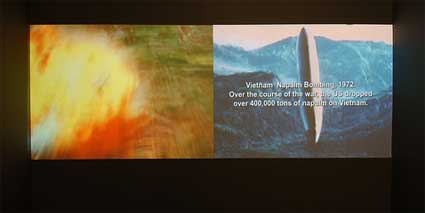
Critical Art Ensemble, Immolation
The result is a video where war crime are shown at both the micro and macro level but which skips the human level. Yet you still manage to view your own body in the narrative. The video is made even more unsettling by the absence of sound, it’s just silence and destruction.
The goal is to provide a different way of imaging, viewing, and interpreting the human costs of these war crimes, in contrast to the barrage of media imagery to which we have become so desensitised. The video portrays what CAE calls an “ecology of crime.”
CAE felt that as long as warfare would be at the center of the Bush agenda, they had to come up with new connections and find venues to show their work (since the arrest of Steve Kurtz some US administrations are feeling the pressure).
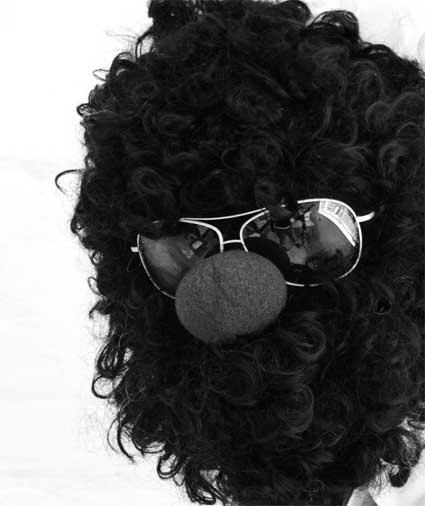
Right next to Immolation, is Truth Serum, a work that responds to the lawsuit against Steve Kurtz and their persecution of Critical Art Ensemble in the USA, which marks an ever-increasing creep of the security state into the nervous system of culture.
For Truth Serum, The Office of Experiments, initiated by Neal White, follows research on serums used historically by official authorities in interrogation processes as a means to obtain information without using torture. The effects of truth drugs were first examined in the 1920’s, and heavily used by the CIA during the Cold War. The present artwork echoes the debate around art’s freedom in the fear and increasing security regime that has emerged after 9/11, while drawing on the cultural history of so-called truth drugs and recent discussions about their use in the interrogation of suspected terrorists.

Scopolamine, an ingredient used in truth serums (image courtesy of Neil White)
The use of truth serums is actually illegal but after 9/11 there have been talks (mostly in the press) of using the method again during interrogations by the FBI and the CIA, even though truth serums are more an art than a science.
The installation at FACT combines a space concealed behind a white door and a series of video works that reflect on the aesthetics of terrorist messages, using a dark clown as an anonymous spokesman who reflects on the possibility of carrying out mass self-experimentation with truth drugs as a form of self-defence.
On 29 March 2008, volunteers will be able to participate to the performative part of the Truth Serum installation in support of freedom from artistic censorship.
In a central (and still secret) Liverpool location, participants will willingly submit themselves to a short psychological experiment based on substantiating Truth lasting around 10 minutes. The aim is to probe an atmosphere of paranoia spreading since 9/11.
More information to participate.
My pictures and FACT pictures.
sk-interfaces is on view until March 30 and launches FACT’s Human Futures programme which includes 3 sections – My Body (SK-Interfaces), My Mind and My World, each one hosting a major exhibition, conference and research focus. You can follow its development through Human Futures blog.
Related: They make art not bioterrorism, Jens Hauser’s presentation in Aix en Provence (part 1 and 2.)
On Saturday, i visited the Biennale de la Photo de Liège. Now you might never have heard of Liège. Good for you! That’s where i grew up and i must say that apart from the sticky Sirop de Liège (which i’ve never really liked but was nevertheless almost forced to eat), a fantastic programme at a couple of independent movie theatres, and Georges Simenon, there is nothing exciting nor even remotely nostalgic i’m ready to say about that city. Pass your way, dear tourist… Unless you happen to be stuck there before March 30.
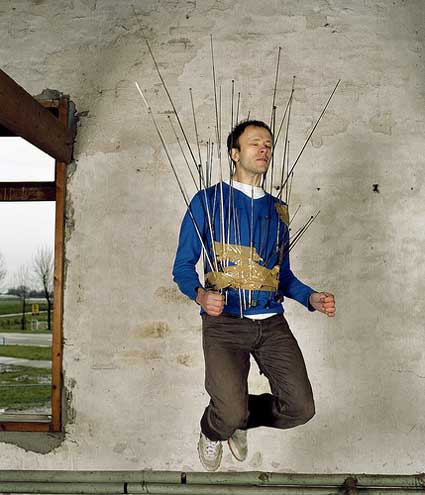
ANOUK KRUITHOF, no title, from the series « We are the blue people », 2007
The concept of Territories is the centre of Liège’s 6th International Biennial of Photography and Visual Arts. This theme is explored through different aspects: “Mental Territory”, “Political Territory”, “Mutating Territory” or the relationship between “Territory and Identities”.
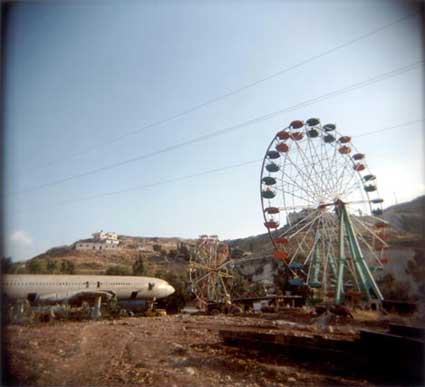
Brigitte Grignet, Nablus, West Bank, June 2005, from the series Palestine, Unfortunately It Was Paradise
The selection is really good but the curators didn’t take any risk. I mean you can’t go wrong with the likes of Edward Burtynsky, Xavier Delory and Patrick Messina, can you? Several aspects of this biennale looked a bit like a re-load of several exhibitions on the same topic i’ve seen over the past couple of years (namely BAC! Living in Babylon in Barcelona and Spectacular City in Rotterdam) but, hey, i enjoyed the biennale a lot so i’m going to stop spitting in the soup now. As I applauded some chapters of the biennale much better than others, i’ll exercise my right to be a subjective blogger and focus only on what grabbed my interest.
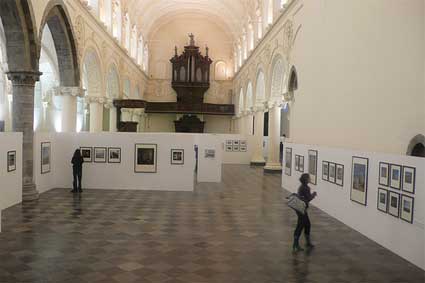
View of the Ancienne Eglise Saint-Antoine
Political Territory
My first stop was at the luminous Ancienne Eglise Saint-Antoine, an ex-church recently restaured with a very profuse helping of white paint. Wars and fights have marked the history of nations but also left stigmas on the landscapes and in the hearts of people. While some of the artists presented in the Political Territory exhibition turned their lens towards the geographical borderline – seen here as either a real or a symbolic delimitation, other photographers reflect on the human and social consequences which inevitably tailgate these geopolitical challenges.
A fascinating place was dedicated to migrants, “unrooted” or displaced persons, all those who move to another land following their own will or obligation and had to somehow adjust and rebuild a new community and identity.
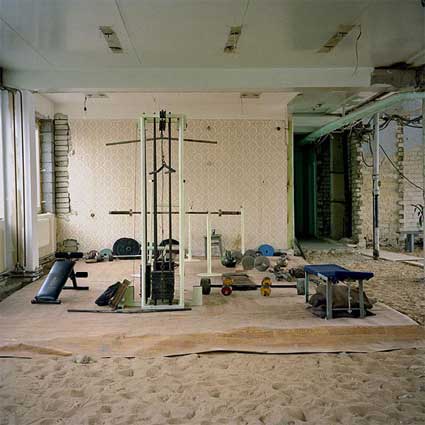
Yann Mingard and Alban Kakulya, from the series «East of a New Eden», 2001-2002
Today, long after the fall of the iron curtain, new reinforcement measures are being put into place. The buffer zone that was formerly made up of the ‘sister countries’ of the URSS, is slowly becoming the European Union’s buffer zone against illegal immigration and illegal traffic.
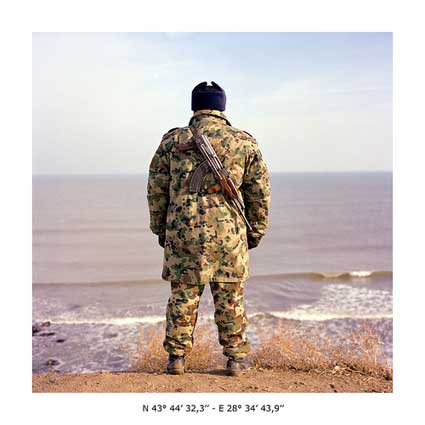
Yann Mingard and Alban Kakulya, N 43° 44′ 32 3” – E 28° 34′ 43 9”, from the
series «East of a New Eden», 2001-2002
In 2002, just before some of the Eastern countries would join the European Union Yann Mingard and Alban Kakulya took a GPS and travelled along the length of Europe’s new frontier, from the Adriatic to the Baltic to give a snapshop of the state of a border separating the European Union from countries of the ex-Soviet Union.
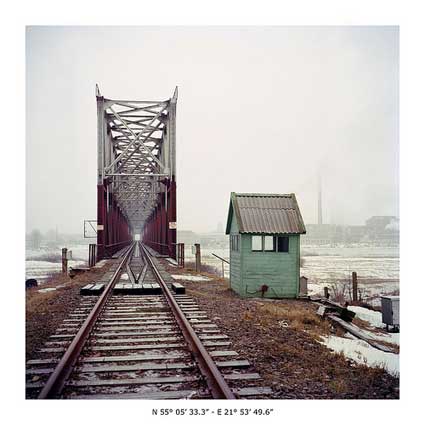
Yann Mingard and Alban Kakulya, N 55° 05′ 33 3” – E 21° 53′ 49 6”, from the
series «East of a New Eden», 2001-2002 (c-print 100x100cm)
East of a New Eden raises a series of questions: What is happening today in a zone where people, who have been accustomed to the standards of the Ancient Regime, are suddenly expected to follow the rules of the European Union? Will the iron curtain be replaced by a high tech surveillance barrier?
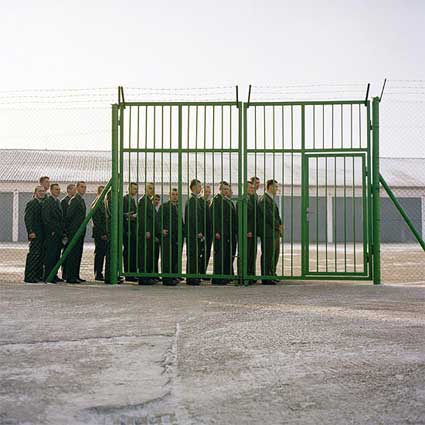
Yann Mingard and Alban Kakulya, from the series «East of a New Eden», 2001-2002
Rip Hopkins traveled to Uzbekistan, a country very few people could locate on a map but also an artificial country as it was peopled “forcibly” by outcasts from various counties of the former Soviet Union. The Displaced (“From Home and Away”) photos are accompanied by a short text which tells the story of one of these Uzbeks who might or might not feel that they really belong there.
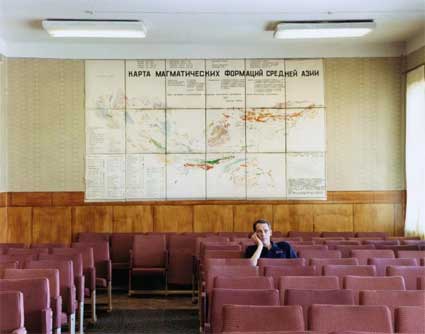
Rip Hopkins, from the series Déplacés, 2002
Leonid Svertchkov in Tashkent’s Geology and Biophysical Institute’s conference room. He is 42 years old. He is Ukrainian and works at the Science Institute as an archeologist specialised in Zoroastrian sites in the south of Uzbekistan bordering with Afghanistan. Leonid was born in East Germany and came to work in Uzbekistan in 1982. He will not leave to join his wife and two sons living in Athens, Greece. 30/07/02
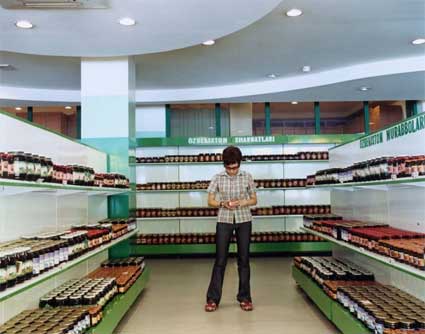
Rip Hopkins, from the series Déplacés, 2002
Lena Olegovna in the shop Les cadeaux de la Dame Nature in the city centre of Tachkent. Lola Karimova, the elder daughter of President Karimov, owns this shop. Lena is 24. She is an english, russian and ouzbek interpret. Her mother is Tatar and her father is half Russian and half Ouzbek. She want to go to Norway. 03/08/02
With Linewatch – Pasaje en la frontera, Laetitia Tura documents the border areas between the United States and Mexico and in particular the police control systems erected across the accidents of the landscape.
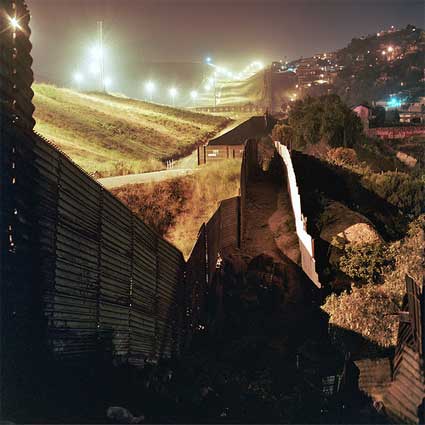
Laetitia Tura, Lumière inquisitrice 7, Colonie Libertad, Tijuana, Mexique, 2005
Jérôme Brézillon‘s series Souverains, Indiens des Plaines is a breathtakingly beautiful and thought-provoking series about the fate of Indian Americans. In 1868 the Treaty of Fort Laramie set the frontiers of the land assigned to the Yanktonai Sioux, Santee Sioux, and Arapaho and stipulates that the land is theirs to use as they deem fit. History showed that their territory was not always respected.
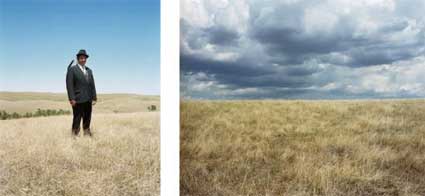
Jérôme Brézillon, Souverains, Indiens des Plaines
In the Souverains (Sovereigns) series Brézillon juxtaposes a portrait of a Sioux Lakotas with a landscape of Indian reservations. An identity relationship is instantly created. History, myth and ancestry ensure that the intimacy cannot vanish so easily nor be reduced to folklore.
Mutating Territory
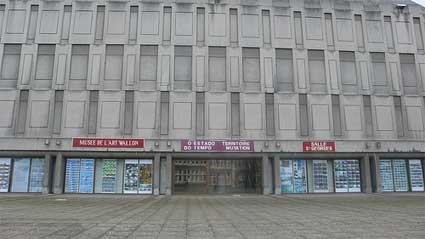
View of the Musée de l’Art wallon
The exhibition Mutating Territory, at the greyer than grey Musée de l’Art wallon, explores how men appropriate a territory and shape it according to their own requirements.
But doesn’t this new territory in turn also shape a new humanity?
Joël Tettamanti toured the globe to document the way mankind takes root in the landscape.
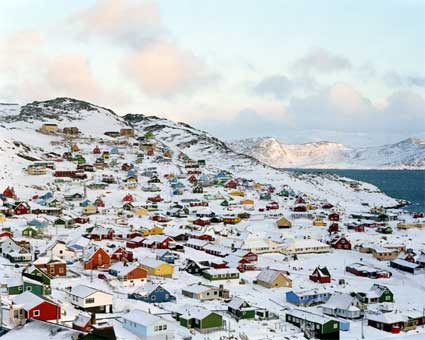
Joël Tettamanti, Qaqortoq_1781
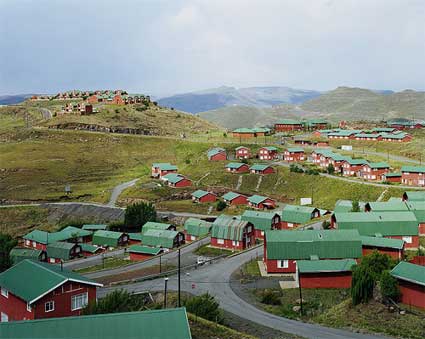
Joel Tettamanti, from the series Maloting, Lesotho, 2004
Edward Burtynsky collects evidences of man’s boundless disregard for the planet: oilfields, polluted ship-breaking beaches, recycling yards, quarries, industrial refineries, etc. He takes images of the colonized landscape but he also enters factories to take sublime shots of intricate industrial constructions or chain workers in the process of loosing any personality.

E. Burtynsky, Oil Refineries No. 14, Saint John, New Brunswick 1999
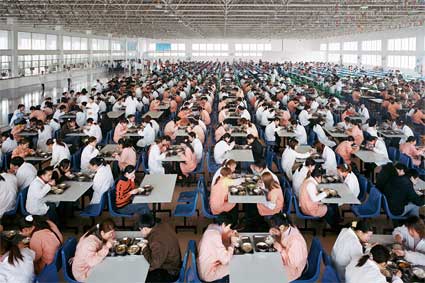
E. Burtynsky, Manufacturing 16, Bird Mobile, Ningbo Province, China 2005
Xavier Delory didn’t have to take any plane to dedicate his attention to the houses “clé sur porte” (key in the door), they are all over Belgium and many other European cities. Manipulating the images to remove any trace of door and window, he leaves us with a soul-less canvas which has no qualm about being in total disharmony with the environment.
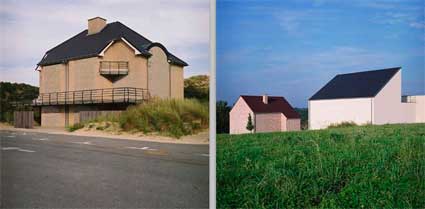
Xavier Delory, from the series Habitat
Mental Territory
I’m going to pretend i haven’t visited Territory and Identities and go directly to Mental Territory at the MAMAC. The territory this time is the one of human intimacy, the internal territory mapped by our choices, family, loneliness, etc. Although i tried as hard as i could there was little attention left for anything else than her pictures the moment i saw Marrie Bot‘s Geliefden. Timeles Love. The series shows elderly having some very intimate moments. Hard not to let your jaw drop and ask your companion “How can they?” “You’ll find me so awful when i’m seventy, we will just hold hands and that’s it right?” Hard to also not to think that these couples are incredibly lucky to still love each other so much after decades of marriage.
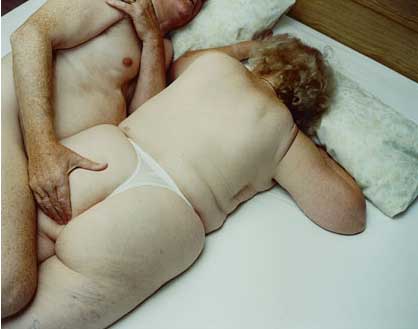
Marrie Bot, Liesbeth (76) and Cor (70), Geliefden-Timeless Love, 2004
Territoires, the 6th Biennial of Photography and Visual Arts is on view at several venues in Liège until March 30.
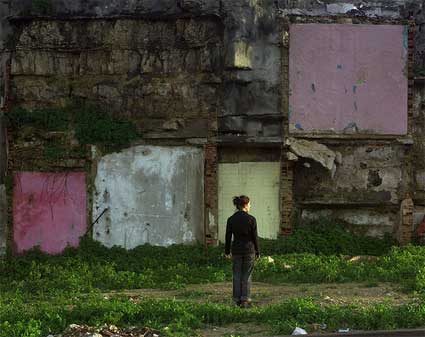
Mathias Nouel, Iris, 2004
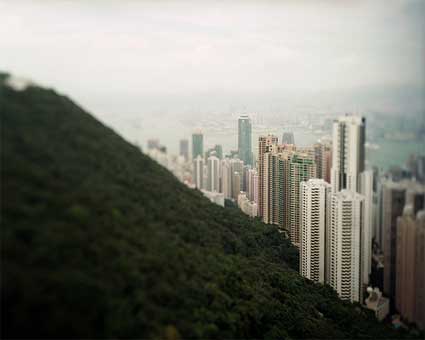
Patrick Messina, from the series «Ma petite Amérique», Courtesy of Label Expositions, Paris
Last month, i went to Florence to visit Emotional Systems, the inaugural exhibition of the brand new Strozzina.
You’re going to hear about the Centre for Contemporary Culture Strozzina (CCCS) in the coming months i’m sure. The space was created as platform for the different approaches and practices that characterise the production of contemporary art and culture. That doesn’t seem much but in a city like Florence which lives and breathes Renaissance there was very little space left for contemporary art so far. Its Project Director Franziska Nori is a curator of new media art (she co-produced and curated produced exhibitions such as I Love You exploring the worlds of hackers and viruses, adonnaM.mp3 devoted to p2p and file-sharing, Digital Origami about the demo scene.) CCCS is not a digital art center though but its mission is to highlight all forms of contemporary culture and this includes media art.
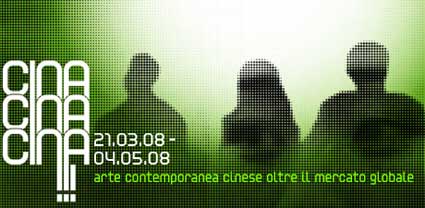
Just to wet your appetite, CCCS’s next exhibition CINA CINA CINA !!! will present the work of 15 contemporary Chinese artists whose artistic practice searches for an independent cultural identity free of the restrictive rules of the global market. It opens on March 21 and closes on May 4.
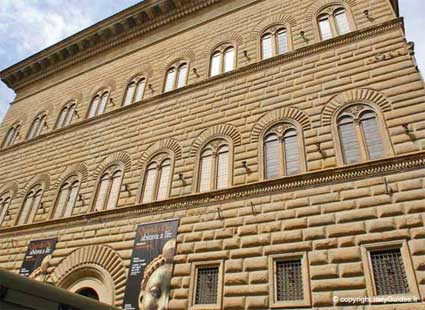
Palazzo Strozzi (image)
The exhibition space is located in the recently restored spaces under the courtyard of Palazzo Strozzi, an impressive don’t-mess-with-me palace in Florence. Its construction begun in 1489 by Benedetto da Maiano, for banker and statesman Filippo Strozzi the Elder, a rival of the Medici who wanted the most magnificent palace as a political statement of his own status. Filippo Strozzi died in 1491, long before the construction’s completion in 1538. Duke Cosimo I de Medici confiscated it in the same year, not returning it to the Strozzi family until thirty years later.
The exhibition that launched the center was Emotional Systems – Contemporary Art between Emotion and Reason. Curated by Franziska Nori and phenomenologist Martin Steinhoff, the show invited the audience to reflect on the relationship between the contemporary artist, the artwork and the viewer, in the light of the latest discoveries in the neurological sciences about the human brain and its effects on the emotions.
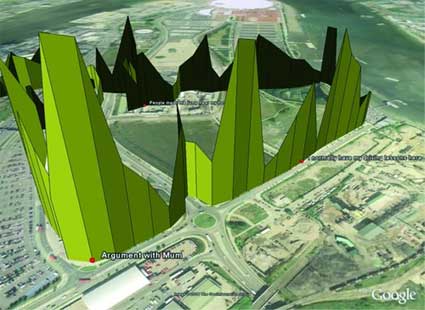
Christian Nold, Emotional Mapping Greenwich, 2005
Each room of the Strozzina is devoted to one artist, each focusing on different aspect of emotion and empathy with the public. All of them are perfectly documented on the exhibition website, but here’s a selection:
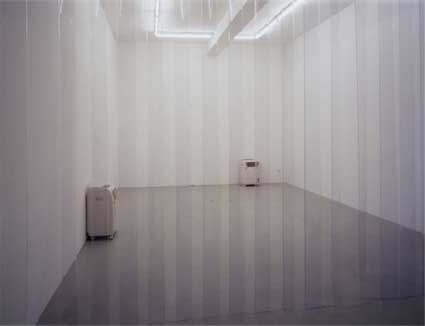
Teresa Margolles, Aire, 2003
Teresa Margolles‘ installation takes you by the guts. The strategy of Air/Aire is as minimalistic as it is powerful, it calls for the immediate reality of experience rather than the power of representation, the whole experience is paradoxicaly triggered not by an image but an absence.
You enter the installation room through a transparent plastic curtain, the kind that you’d expect to find in the workshop of a butcher. The room is completely white and apparently empty apart from a working air-conditioning unit. The air is slightly humidified.
That’s it, so you either pass your way thinking that it is just an empty room or spot the exhibition label and start to read the elements used in making the installation: the conditioning system and vaporised water.
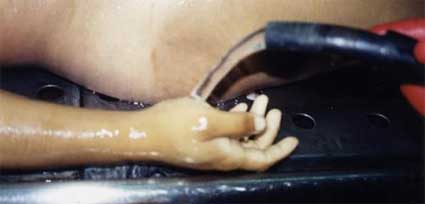
Image from an other work of the artist: Muerte sin fin
As a visceral motor reaction, disgust is included together with fear and pain among the primary emotions pinpointed by Italian neuroscientist Professor Giacomo Rizzolatti as underlying the so-called “mirror mechanism”.
 The active agents of this mechanism are the mirror neurons in the brain, a particular class of neurons characterized by the property of firing not only when the individual performs a particular action but also when he or she sees or simply hears someone else perform it. In short, when someone observes a work of art, this triggers a sort of re-creation in the sense that the viewer does not remain passive but projects his or her ‘inner state’ onto it.
The active agents of this mechanism are the mirror neurons in the brain, a particular class of neurons characterized by the property of firing not only when the individual performs a particular action but also when he or she sees or simply hears someone else perform it. In short, when someone observes a work of art, this triggers a sort of re-creation in the sense that the viewer does not remain passive but projects his or her ‘inner state’ onto it.
A good example of this emotional transfer is Bill Viola‘s video series The Passions in which everyday people perform scenes from the classic Christian iconography. The figures are extrapolated from religious symbology and re-contextualized in a timeless and universally poetic dimension as a metaphor of the essence of the human condition.
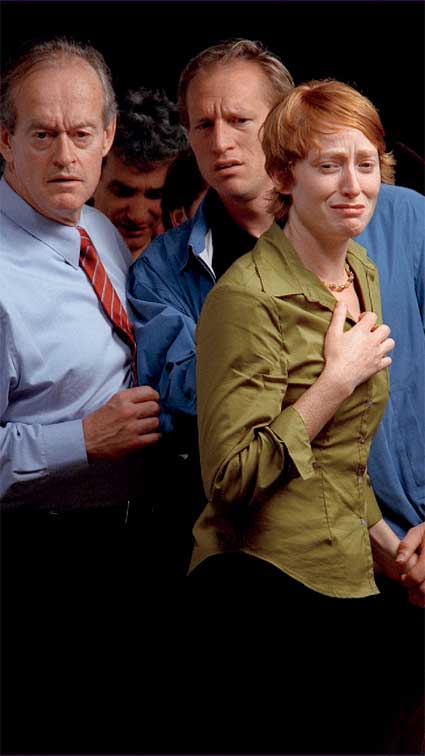
Bill Viola, Observance, 2002. Photo credit Kira Perov
Observance draws inspiration from Albrecht Dürer‘s The Four Apostles (1526), a pair of altar wings depicting the grief shared by the four apostles over the death of Christ. It has sometimes been said that the work can be taken partly as a response to September 11. Actors enter and exit the performance space with their eyes fixed on a set point that remains hidden but seem to be located in the spectator’s space.
Although we are not permitted to see the cause of the performers grief, we can guess that death and loss are the reason for their emotion. It’s hard not to think of 9/11. The entire action unfolds in silence and extreme slow motion.
The third work i’d like to highlight is Nomadic Time, an installation, devised by Andrea Ferrara, a.k.a. Ongakuaw, which involves the connecting of a performer to a machine that detects her brainwaves.
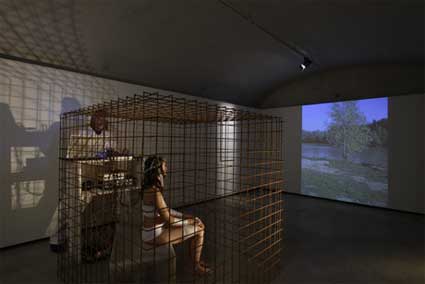
The device monitors four types of waves generated by the human brain:
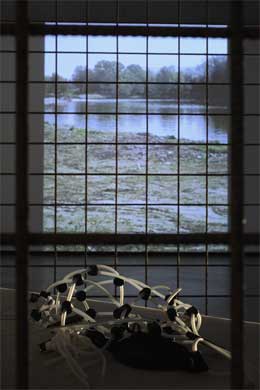 alpha waves which come from the subconscious mind and are generated primarily by the region of the memory, upon which the subconscious is based; beta waves which are born in the conscious mind, and are related to all activities during the awake state when the person is concentrated on external stimuli; theta waves which constitute waves of psychical power together with delta waves; gamma waves which are those of the deep psychical powers, like those of a medium in a trance.
alpha waves which come from the subconscious mind and are generated primarily by the region of the memory, upon which the subconscious is based; beta waves which are born in the conscious mind, and are related to all activities during the awake state when the person is concentrated on external stimuli; theta waves which constitute waves of psychical power together with delta waves; gamma waves which are those of the deep psychical powers, like those of a medium in a trance.
While the performer is closed in the cage like a laboratory animal. She is made to watch a video,while her emotional response in the form of waves emitted by the brain is recorded, codified and digitally sampled by computer.
The video sequence shows 257 still shots of a tree by the River Arno, photographed by the artist in the course of the year.
The number of these shots corresponds to the number of days that Ferrara was actually on the spot to photograph the tree. The days when he could not make it are symbolized by single black image that appears for a fraction of a second on the screen and have only a subliminal impact on the spectator. This absence is also represented by the absence of the performer in the moments when the performance is suspended, leaving just the objects in an empty cage.
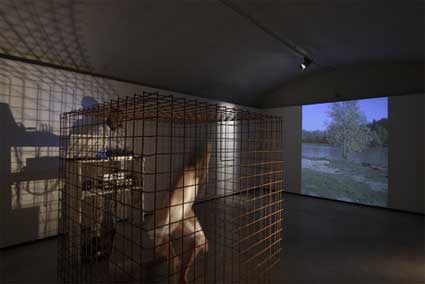
The coding is used as a control for an algorithmic compositional strategy of acoustic data. A custom-built software translates the waves recorded into musical sounds broadcast in the exhibition space, and the sound thus generated represents a real-time mapping of the emotions felt by the performer.
I’d also like to recommend the catalog that accompanies the exhibition as a way to explore the subject. It’s in fact a carefully selection of essays by neurologists, philosophers, anthropologists, art historian, and the curators who present with the peculiar perspective of their own discipline the rationality of emotions and, in David Freedberg’s words, the “relations between the formal aspects of an image and the emotional responses” of the user.
More images on flickr and CCCS.
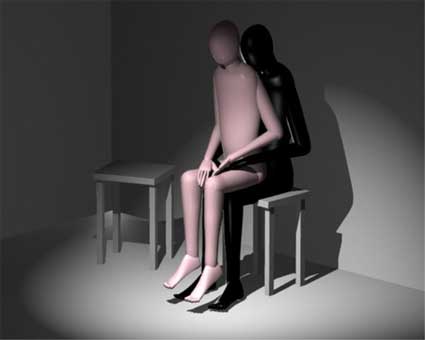
Yves Netzhammer, The Subjectivisation of Repetition, 2007
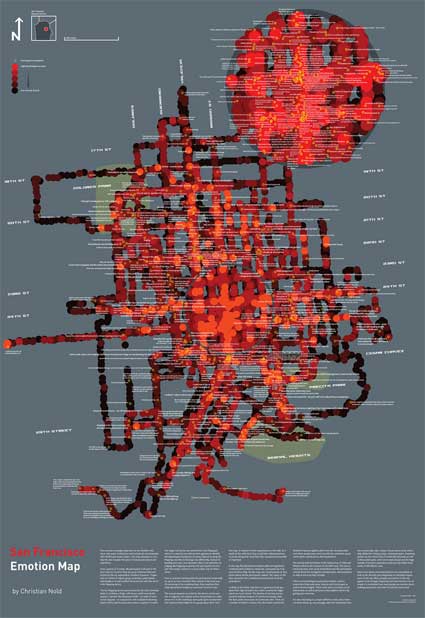
Christian Nold, Emotional Mapping San Francisco, 2007
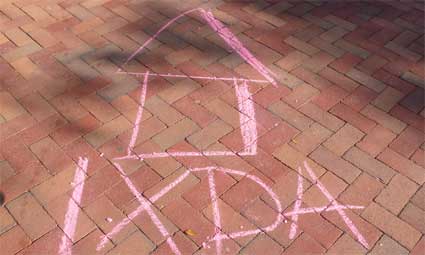
I’m just back from the IxDA Interaction 08 conference organized by the Savannah College of Art and Design in Savannah, Georgia. My favourite talk was Strategic Boredom by Molly or how two visionaries from the ’50s and ’60s could teach us something about introducing boredom into interaction.
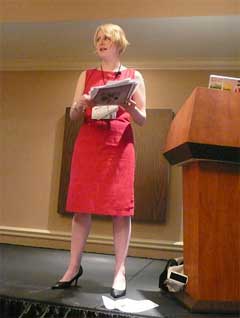 Molly Wright Steenson is a PHD student in architecture at Princeton University and an interaction designer.
Molly Wright Steenson is a PHD student in architecture at Princeton University and an interaction designer.
When i realized that Molly posted most of her talk on her new blog Conceptual Device, i thought i could just add it to my del.icio.us links but then it would be lost for most of my readers. So i’m going to let you read the intro on her site and take over with what i wrote down during her talk, from the moment when she focused on Gordon Pask and Cedric Price. Not sure it makes much sense but it does make me happy. This blog was born out of a need to archive what could serve my own enlightenment after all.
Martin Heidegger studied boredom in Fundamental Concepts of Metaphysics as part of his continual exploration of existence. At some point he suggested an interesting strategy when facing boredom: “not to resist straightaway but to let resonate… only by not being opposed to it, but letting it approach us and tell us what it wants, what is going on with it.”
The idea of exploring boredom took an interesting turn with cybernetics,
Louis Kauffman, President of the American Society for Cybernetics, defines cybernetics as “the study of systems and processes that interact with themselves and produce themselves from themselves”.
There is first order cybernetics (not much interaction here) and second order cybernetics (an organism or social system is an agent in its own right, interacting with another agent, the observer.)
Gordon Pask was interested in Second Order Cybernetic. Pask had a PHD in psychology and was particularly interested in learning and conversations.
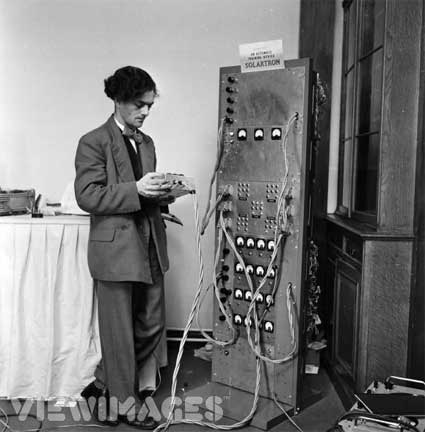
Gordon Pask (Photo by Harry Kerr/BIPs/Getty Images)
In 1953, Pask created the Musicolour machine. The machine was inspired by the concept of synesthesia and aimed at exploring what happens when music and light interact with each other. He’s the only one nor the first to work on such idea but what makes the Musicolour interesting is that Pask introduced the notion of boredom in the equation.
The work held a “conversation” with the performer. The musician would respond to visual queues, the machine in turn would build an understanding of what the musician was playing, and, when it detects that the musician is repeating a same sequence too often, the system would “get bored” and challenge the musician to find new ways to re-engage the system.
The idea of building upon boredom reappears with Cedric Price‘s Generator. Just like Archigram, Price didn’t build much but his radical ideas had a huge influence on contemporary architecture. At the core of Price’s practice was the belief that new technology could enable the public to gain control over their environment, resulting in a building which could be responsive to visitors’ needs and the many activities intended to take place there.
The Fun Palace, probably his most influential projects, was never realized but it nevertheless inspired the Centre Georges Pompidou that Richard Rogers and Renzo Piano built ten years later in Paris.

Fun Palace, an unrealised project for East London, 1960-1961
Price became also famous for his project of a mobile university on rails, the Potteries Thinkbelt (1965). He proposed the conversion of declining industrial zone into a huge High Tech think-tank, with mobile classrooms and laboratories mounted on the rail lines, moving from place to place, from housing to library to factory to computer center.
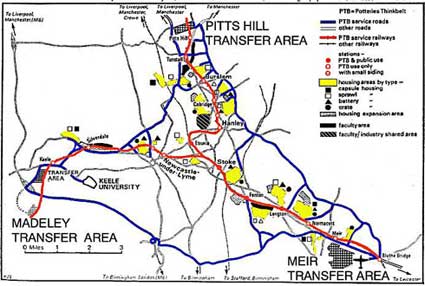
Plan for Potteries Thinkbelt, Staffordshire, England, 1965
Price was not interested in formalism but in conditions that would change people behaviour through their interaction with architecture.
The idea reappears in Price’s Generator (1976-79, not built). This series of cubes, screens, walkways and catwalks could be moved around by a mobile crane on the site to meet visitors’ needs and desires. Price’s collaborator John Frazer, proposed that the cubes be outfitted with sensors that would report on the use of the components. If the pieces of Generator weren’t moved enough, they would grow bored and design their own layouts, which in turn would be handed off to the mobile crane operator to put into place.
 In an interview with Hans Ulrich Obrist, Price declared:
In an interview with Hans Ulrich Obrist, Price declared:
In defining architecture, you don’t necessarily define the consumption of it. All the designs we did for Generator [Florida, 1966] were written as menus, and then we would draw the menu, and because I like bacon and eggs for breakfast, it was all related to that bit of bacon and that bit of egg. They were all drawn, however cartoon-like, in the same order – not in the order the chef or cook would arrange them on your plate, but in the order in which the consumer would eat them. And that is related to the consumption or usefulness of architecture, not to the dispenser of it.
Generator would also have the task to surprise its users. In collaboration with programmer-architects John and Julia Frazer, he imagined that each element of Generator would become “intelligent” by being outfitted with a microchip. The sensors would interact with four computer programs that performed a variety of tasks, including keeping inventory, aiding Generator’s users to design different layouts, and most powerfully and importantly, getting bored. The boredom routine would run if people did not request changes of Generator frequently enough, or if the parts were not aptly used. It would draw up new plans for Generator, which would be handed off to the social elements of the project.
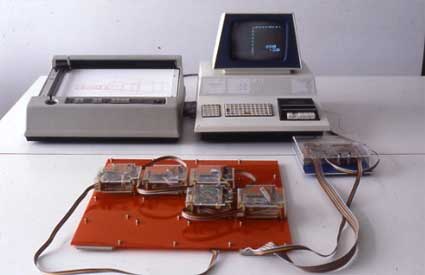
John and Julia Frazer, Generator Electronic Model
In the correspondence between Price and his system research consultants Julia & John Frazer, Molly encountered this thought-provoking sentence: “If you kick a system the very least you would expect is for them to kick you back.”
What interested Price was not to design the perfectly controlled system but to create a Generator which would make things that neither the architect nor the users expect, a system that gets involved and plays an active role once it gets bored. That was his idea of interaction: a troublesome system that bites back, that engages in a conversation and do things you wouldn’t have thought about, no matter how carefully you have devised that system.
Previously: Paskian Environments.
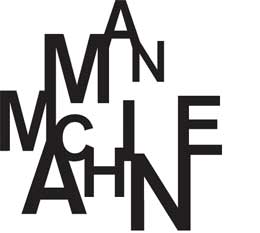 Last week (or was it two weeks ago already?) i was in beautiful Stockholm to visit the Man Machine 2 exhibition, produced at the Interactive Institute and curated by Björn Norberg.
Last week (or was it two weeks ago already?) i was in beautiful Stockholm to visit the Man Machine 2 exhibition, produced at the Interactive Institute and curated by Björn Norberg.
What makes the show particularly interesting was the whole production process. It all started from scratch, only a few months before the opening of the exhibition, with a brainstorming where contemporary artists Matti Kallioinen, Ebba Matz and Christian Partos shared views and experience with engineers. The questions the discussion focused on revolved around the way we use the machine and how the human mind and body have interplayed with the machine historically and how man and machine will interact in the future.
After that the artists got the opportunity to have a peak inside the National Museum of Science and Technology‘s storage facility (usually closed to the public). Going from shelf to shelf the artists got to know the story of some of the artefacts belonging to the Museum’s collection and were invited to position this technological cultural heritage in relation to their own artistic expression. Throughout the process the artists were in constant dialog with engineers, the Interacting Institute and the curators from the National Museum of Science and Technology.
Which brings me to another peculiarity of the show: it takes place inside a museum of technology. Not an art gallery, nor a contemporary art museum. This situation reflects one of the Interactive Institute’s missions: to bring media art and interactive pieces outside of its usual territory and give it a broader audience.
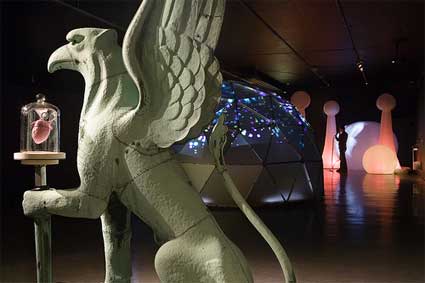
Photo Truls Nord
The artists were asked to choose one artefact each out of the collection. Partos chose a pacemaker, Kallioinen a wooden bellows and Matz a perpetuum mobile.
What i also found worth noting is that. if Christian Partos is used to work with technology Kallioinen and Matz were less familiar with it.
“One important thing with the “Man Machine concept” has been to create a platform where artist and engineer meet, exchange ideas and solve problem together,” Björn Norberg, the curator of Man Machine 2, told me. “There’s a lot of inspiration from E.A.T. and Billy Klüver, the pool that matches engineers and artists. When I was given the chance for both Man Machine and Man Machine 2 and decided to take the opportunity to work with artists that I hadn’t been working with before but also to create a mix in between them, both as artists and in the knowledge about technology and the age of them.”
“If the artists are just open minded, are used to work in different materials and have a lot of ideas there will always be interesting to let them play around with technology and let them meet engineers. The knowledge about technology is then less important.”
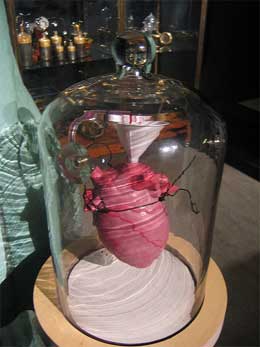 The first clinical implantation into a human of a fully implantable pacemaker was in 1958 in Solna, Sweden, using a pacemaker designed by dr Rune Elmqvist . Christian Partos’ installation has the same role as the pacemaker: it keeps a heart beating.
The first clinical implantation into a human of a fully implantable pacemaker was in 1958 in Solna, Sweden, using a pacemaker designed by dr Rune Elmqvist . Christian Partos’ installation has the same role as the pacemaker: it keeps a heart beating.
The griffins were created for the roof of the building of the national telegraph board that was located in central Stockholm but had somehow found their way to the museum’s back yard. Partos rescued them and trusted them with a display case filled with shiny objects taken from the museum’s collections. Each creature is holding a plate with a glass bell jar, one containing an ancient clock and one containing what appears to be a beating human heart. When the heart beats, is squirts out a red liquid from a tube. The liquid pours down into a small plastic funnel and from there back into the heart.
The accompanying soundscape evokes slow heart beats. It is actually made by picking up the sounds from the room and looping them back.
Video of the installation.
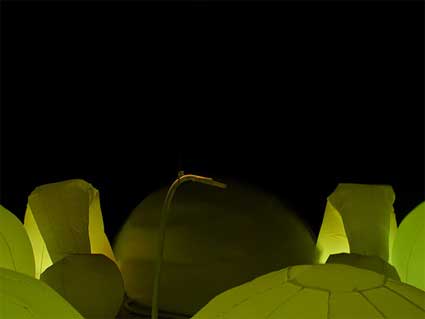
Photo Erik Sjödin
Matti Kallioinen had an idea of working with air in some way. He liked the idea that air needs to be enclosed before you can use it as a power. His choice was a wooden bellows of the type used in the old iron factories.
In his installation The Food chain and Dream World of the Organism the audience and a sophisticated sensor controlled fan construction function as bellows. Erik Sjödin has some amazing images from the installation and a performance.
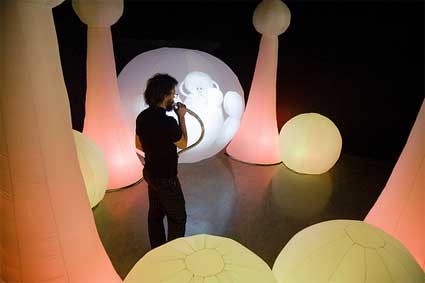
Photo Truls Nord
Visitors can pick up their own tube of plastic and use it to blow up a whole landscape of shapes in just a few seconds (ventilation fans are there to make it much easier and swifter). The landscape acts like an organism, it respond to breath by shifting in color, emitting sounds and by growing in size. After a few seconds, eerie ghost-like figures appear on the surface of the structure.
Erik Sjödin, who has worked on the installation together with the artist explains how it works:
The sound scape that surround the installation, the color of the bodies and the rate at which the colors shifts is determined by the growth of the installation and the airflow measured in the tube. The growth of the installation is monitored by five ultrasonic range sensors, its color is set by sixteen green and red lamps who illuminate the bodies from their insides. A video projection with accompanying sound fades in and out on the center sphere as it is inflated and deflated. When no one is interacting with the installation it emits ambient sounds and slowly shifts color while occasionally inflating itself slightly. A spotlight illuminates the umbilical cord so as to invite people to grab it and start interacting with the installation.
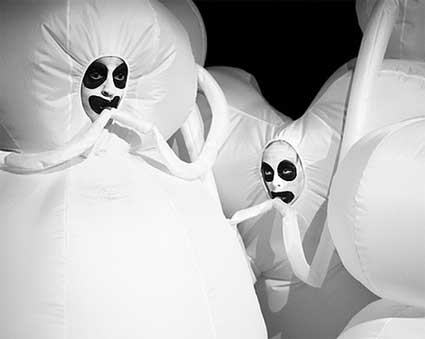
Photo Truls Nord
The performance and costumes of the ghosts were created specifically for the installation (videos from the event which took place in New York 1 and 2.)
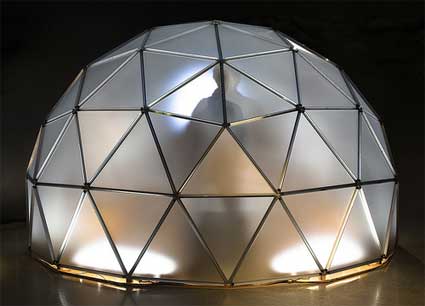
Photo Truls Nord
Swedish inventor P J Hoffring built perpetuum mobile and called it “Paradox”, alas! it hardly ever worked. His struggle to fight against the laws of nature inspired Ebba Matz’ dome in the exhibition.
Matz’ dome takes you to a journey inside a kaleidoscope. The inside is covered of mirrors and when you move inside you are surrounded by images of yourself in an endless repeat.
But the mirrors are not just mirrors. Images leaks in from the outside and are mixed with the reflection of the mirror. The mirror is not just a reflecting surface but also the boundary between outside and inside and the connection between what happens inside and what is projected from the outside.
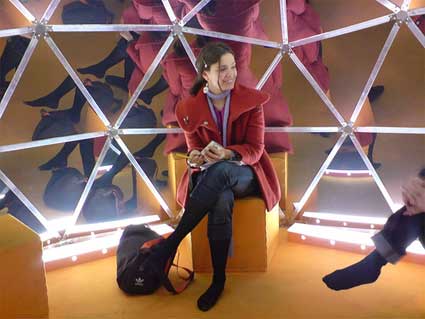
Image by Ingvar Sjöberg
Right after the pendulum, the artist`s inspiration was the Pepsi Pavilion created for the Expo ’70 in Osaka. The Pavilion’s interior dome immersed visitors in 3D images generated by mirror reflections and in spatialized electronic music.
The original structure of the pavilion consisted of a Buckminster Fuller-style geodesic dome. With some of his projects, and in particular his Dymaxion House, Buckminster Fuller was dreaming of solving the energy and housing problems for ever. Hoffring´s pendulum was also looking for the eternal solution, the one of never-ending movement.

E.A.T. – Experiments in Art and Technology, «Pepsi Pavilion for the Expo ’70», 1970
Photograph: Fujiko Nakaya | ©
All the works were built in few weeks using open source technology: Processing, Arduino, Open Framework.
My images.
The Physical Interaction Lab has some more info and videos.
Until April 28, at the Museum of Science and Technology in Stockholm. Man Machine is a part of the node.stockholm festival which runs until February 15 throughout the city.
DLD panel on Future City (Part 1)
Last part of the notes i took during Future City, a panel curated by Carson Chan and Johannes Fricke and moderated by Kazys Varnelis. After Richard Saul Wurman, Patrik Schumacher, Charles Renfro, Bjarke Ingels took the stage for a memorable performance. I thought he deserved a whole post because his work is slightly less famous than the one of the other panelists. Besides, i never found the time to blog the works That he and his team were showing at the exhibition New Faces in European Architecture: David Adjaye, Jürgen Mayer H., PLOT=BIG+JDS, SeARCH at the NAI in Maastricht last year.
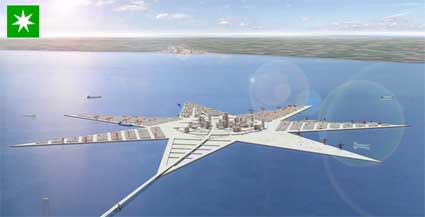
After co-founding PLOT Architects in 2001, Bjarke Ingels started his own office in 2006: BIG / Bjarke Ingels Group. Their work combines experimentation sustained by specific knowledge, social responsibility and humour. Three of his projects were the focus of his presentation: Superharbour, REN and Kløverkarreen.
The Superharbour project was an attempt to re-invent the role of an architect regarding the constant evolution of seas. It started with a proposal to “re-design Denmark, to re-brand the country”.
Video of the Superharbour project:
The project started with a few facts:
– 40% of the coast line in Denmark is urbanized (compared to only 12% of the whole country), urbanity in the country is defined by the proximity to the sea. 2/3 of the Danes live within 5 km of the sea. But it is harbour and its industries that occupy the best plots of land.
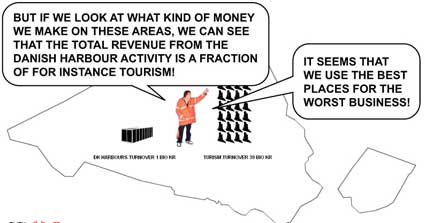
– Containerization. 98% of goods travel on ships. Over time container ships have become bigger ad bigger and they also reach deeper in the ocean. As a result, boats cannot pass between Germany and Finland anymore. Solution envisioned by BIG: bridge the two countries by combining a bridge and a tunnel: the hybrid solution would cost less than building a full-length bridge or tunnel and would create an artificial island.
BIG proposed to use the island (located thus at the intersection between Europe and Scandinavia as well as between the “new” Europe and the rest of the world) as a Baltic super harbour where all the shipping traffic would be concentrated. According to BIG’s analysis, the island would liberate 20 billion euros of prime real estate in Denmark’s 12 biggest cities for new forms of life, instead of pushing people to the periphery of the cities where they want to live. Shaped like a star, the harbour will be organized around piers, each of them focusing its activities on its own program and uses.
People’s Building (aka REN)
Video of the project:
The principle of Yin Yang and the 5 elements of Feng Shui are embedded in the architecture of the Hotel & Conference Center Shanghai (REN)
It actually started as a project for a hotel in Sweden. But the building was never made. Later on, the architects discovered that the shape of the building is the same as the Chinese character ‘Ren’ which means People. The Chinese liked the building as they felt that it “bridges the gap between traditional China and progressive China.”
“The REN Building is a proposal for a hotel, sports and conference center for the World Expo 2010 in Shanghai. The building is conceived as two buildings merging into one. The first building, emerging from the water, is devoted to the activities of the body, and houses the sports and water culture center. The second building emerging from land, is devoted to the spirit and enlightment, and houses the conference center and meeting facilities. The two buildings meet in a 1000 room hotel, a building for living. The building becomes the Chinese sign for ‘The People’, and a recognizable landmark for the World Expo in China.”
Kløverkarréen (aka The Clover Block):
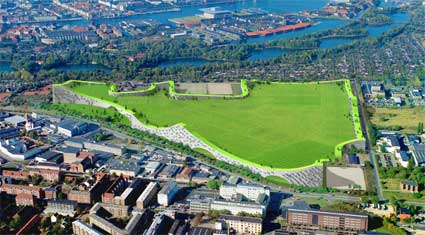
Having followed the debate of the skyrocketing cost of market rate housing in the centre of Copenhagen, the designers of BIG wanted to come up with a new affordable housing proposal which would create 2,000 units. Their initiative came on the heels of Mayoral candidate Ritt Bjerregaard campaign pledge to fund 5,000 units of affordable housing to teachers, firemen, nurse and community service professionals, etc who can’t afford to live in the center anymore. Following their habit of not waiting for a competition to be launched or for a developer to bring the designers a proposal, they started the Kløverkarréen project at their own initiative.
Kløverkarréen is built along the perimeter of a large recreational area, and will house 2,000 residents without losing a single recreational field. It is located closed to public transportation hubs, and to the city centre. The structure would provide generous daylight flats, a wind and noise barrier for people playing football in the recreational field (+ an audience for any match is always on hand), and it would be covered by a rooftop that can be used as a 3 kilometre promenade. BIG dubbed it “the Great Wall of China of housing.”
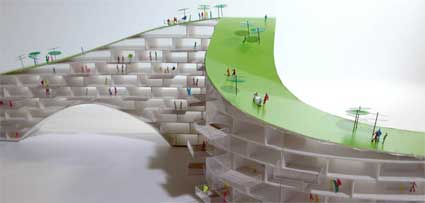
The new mayor was seduced by the idea, the football clubs who usually train on the field agreed with the idea. However, some people in the neighbourhood did not want to share their green oasis with the less wealthy and opposed the development. A survey was carried and and it emerged that 64% of Copenhagen’s citizens thought the project was a good one. A few months later, it was decided that project would indeed be carried out.
Bjarke Ingels believes that the role of architects is a constantly evolving one, they have the responsibility to make sure that the city evolves in the right direction.